Form 8-K CATALYST BIOSCIENCES, For: Sep 28
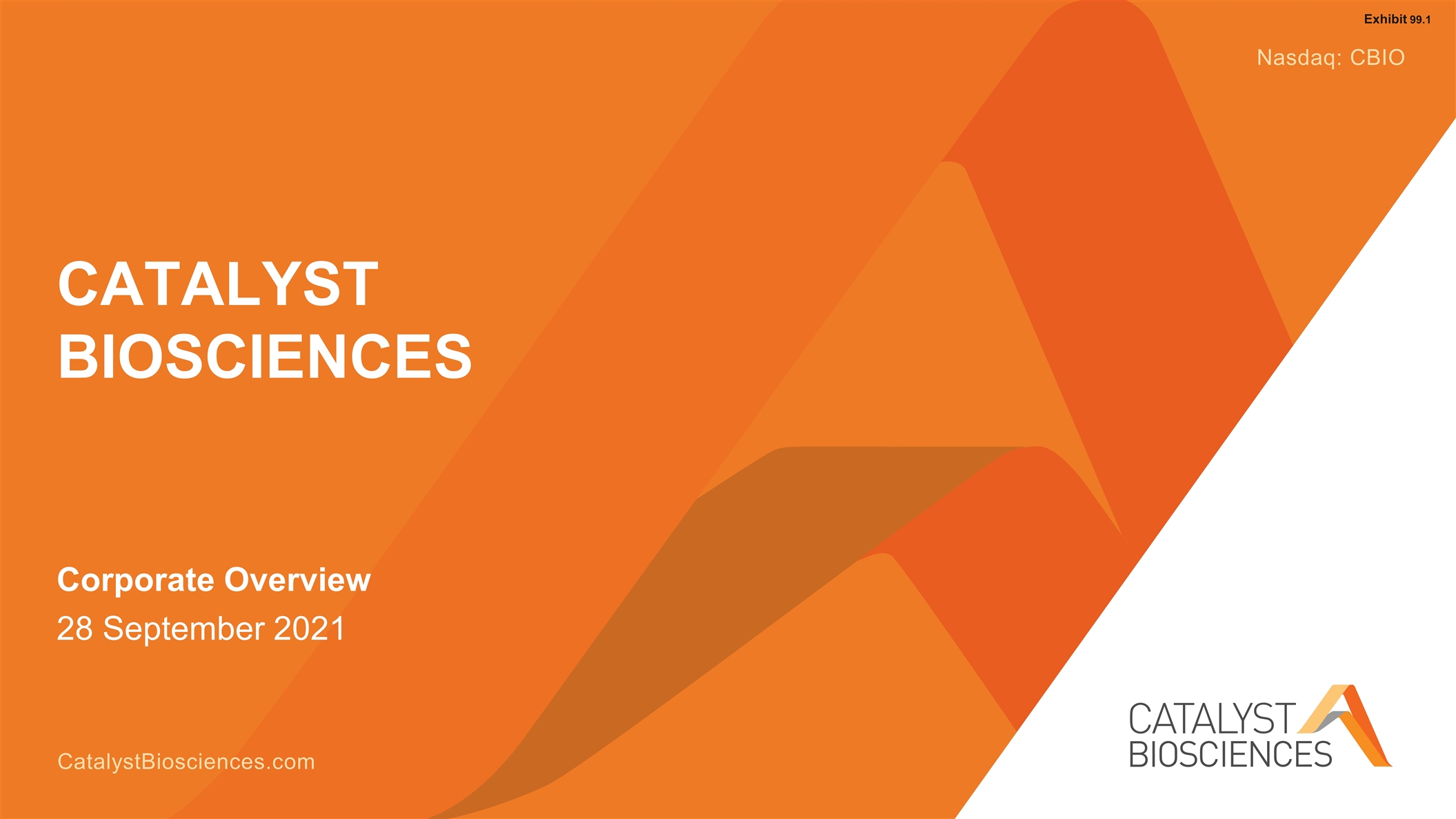
CATALYST BIOSCIENCES Corporate Overview 28 September 2021 Exhibit 99.1
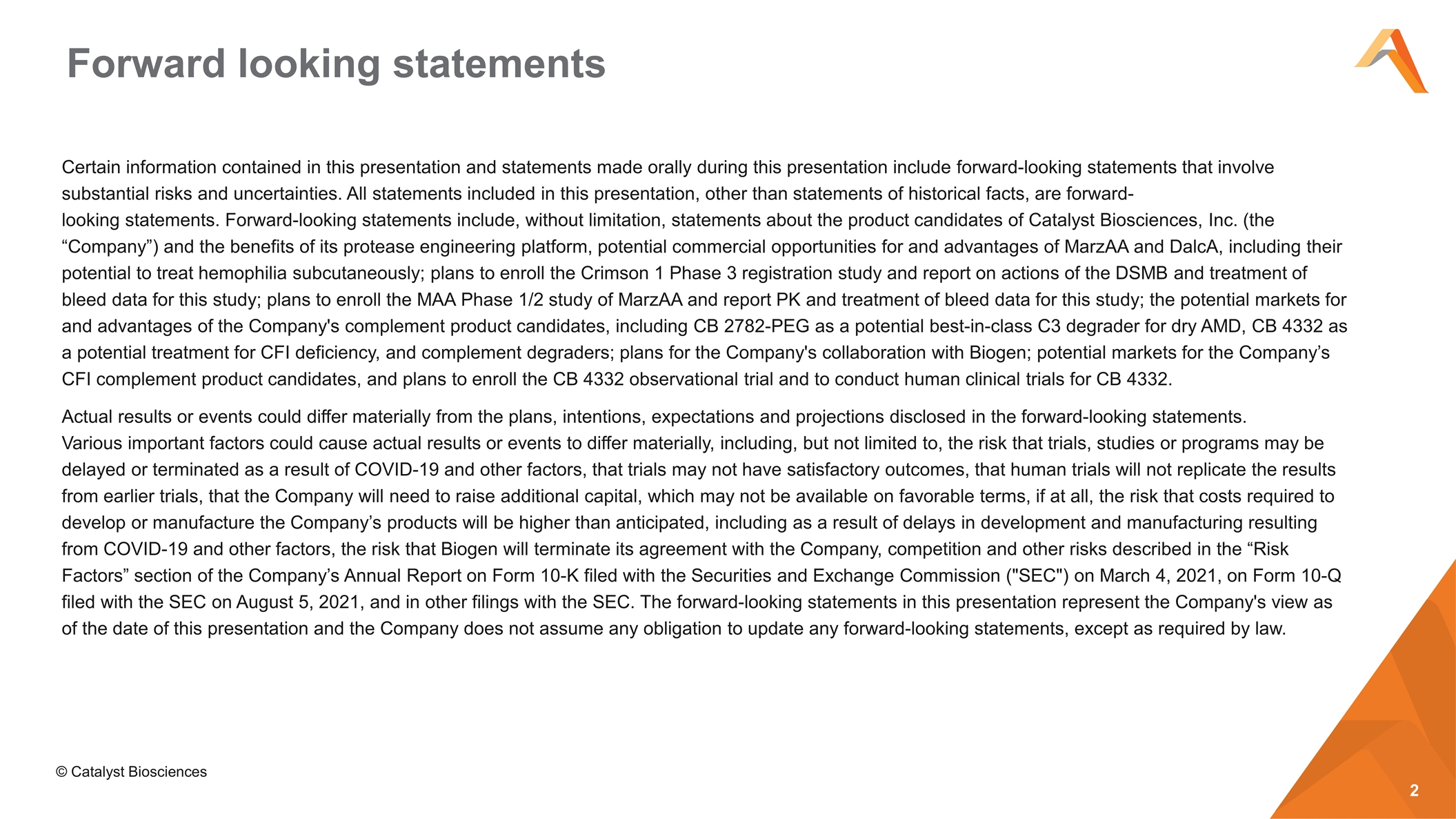
Forward looking statements Certain information contained in this presentation and statements made orally during this presentation include forward-looking statements that involve substantial risks and uncertainties. All statements included in this presentation, other than statements of historical facts, are forward-looking statements. Forward-looking statements include, without limitation, statements about the product candidates of Catalyst Biosciences, Inc. (the “Company”) and the benefits of its protease engineering platform, potential commercial opportunities for and advantages of MarzAA and DalcA, including their potential to treat hemophilia subcutaneously; plans to enroll the Crimson 1 Phase 3 registration study and report on actions of the DSMB and treatment of bleed data for this study; plans to enroll the MAA Phase 1/2 study of MarzAA and report PK and treatment of bleed data for this study; the potential markets for and advantages of the Company's complement product candidates, including CB 2782-PEG as a potential best-in-class C3 degrader for dry AMD, CB 4332 as a potential treatment for CFI deficiency, and complement degraders; plans for the Company's collaboration with Biogen; potential markets for the Company’s CFI complement product candidates, and plans to enroll the CB 4332 observational trial and to conduct human clinical trials for CB 4332. Actual results or events could differ materially from the plans, intentions, expectations and projections disclosed in the forward-looking statements. Various important factors could cause actual results or events to differ materially, including, but not limited to, the risk that trials, studies or programs may be delayed or terminated as a result of COVID-19 and other factors, that trials may not have satisfactory outcomes, that human trials will not replicate the results from earlier trials, that the Company will need to raise additional capital, which may not be available on favorable terms, if at all, the risk that costs required to develop or manufacture the Company’s products will be higher than anticipated, including as a result of delays in development and manufacturing resulting from COVID-19 and other factors, the risk that Biogen will terminate its agreement with the Company, competition and other risks described in the “Risk Factors” section of the Company’s Annual Report on Form 10-K filed with the Securities and Exchange Commission ("SEC") on March 4, 2021, on Form 10-Q filed with the SEC on August 5, 2021, and in other filings with the SEC. The forward-looking statements in this presentation represent the Company's view as of the date of this presentation and the Company does not assume any obligation to update any forward-looking statements, except as required by law. © Catalyst Biosciences
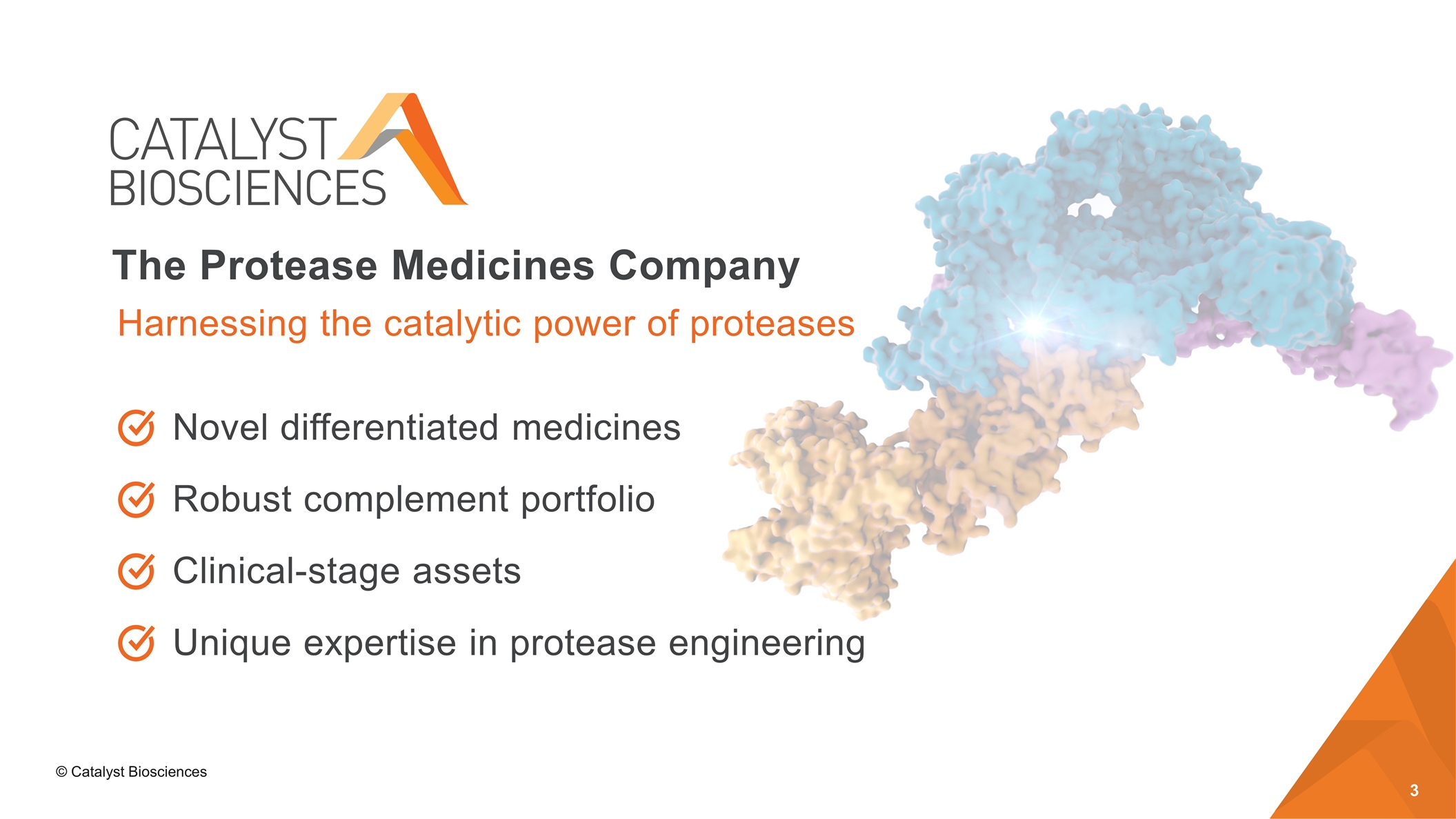
Novel differentiated medicines Robust complement portfolio Clinical-stage assets Unique expertise in protease engineering Harnessing the catalytic power of proteases The Protease Medicines Company © Catalyst Biosciences
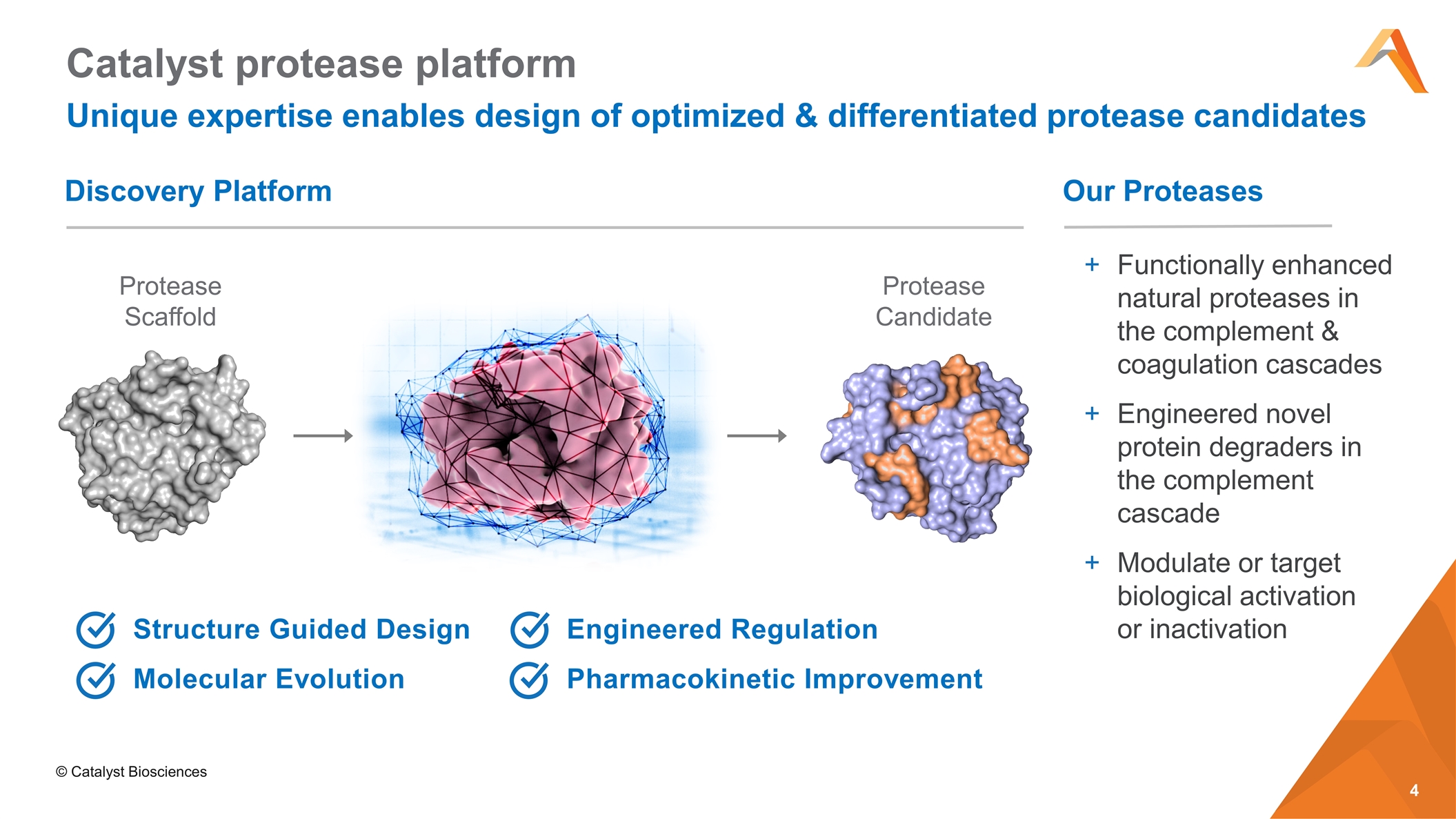
Unique expertise enables design of optimized & differentiated protease candidates Catalyst protease platform Functionally enhanced natural proteases in the complement & coagulation cascades Engineered novel protein degraders in the complement cascade Modulate or target biological activation or inactivation Protease Scaffold Protease Candidate Our Proteases Discovery Platform Engineered Regulation Pharmacokinetic Improvement Structure Guided Design Molecular Evolution © Catalyst Biosciences
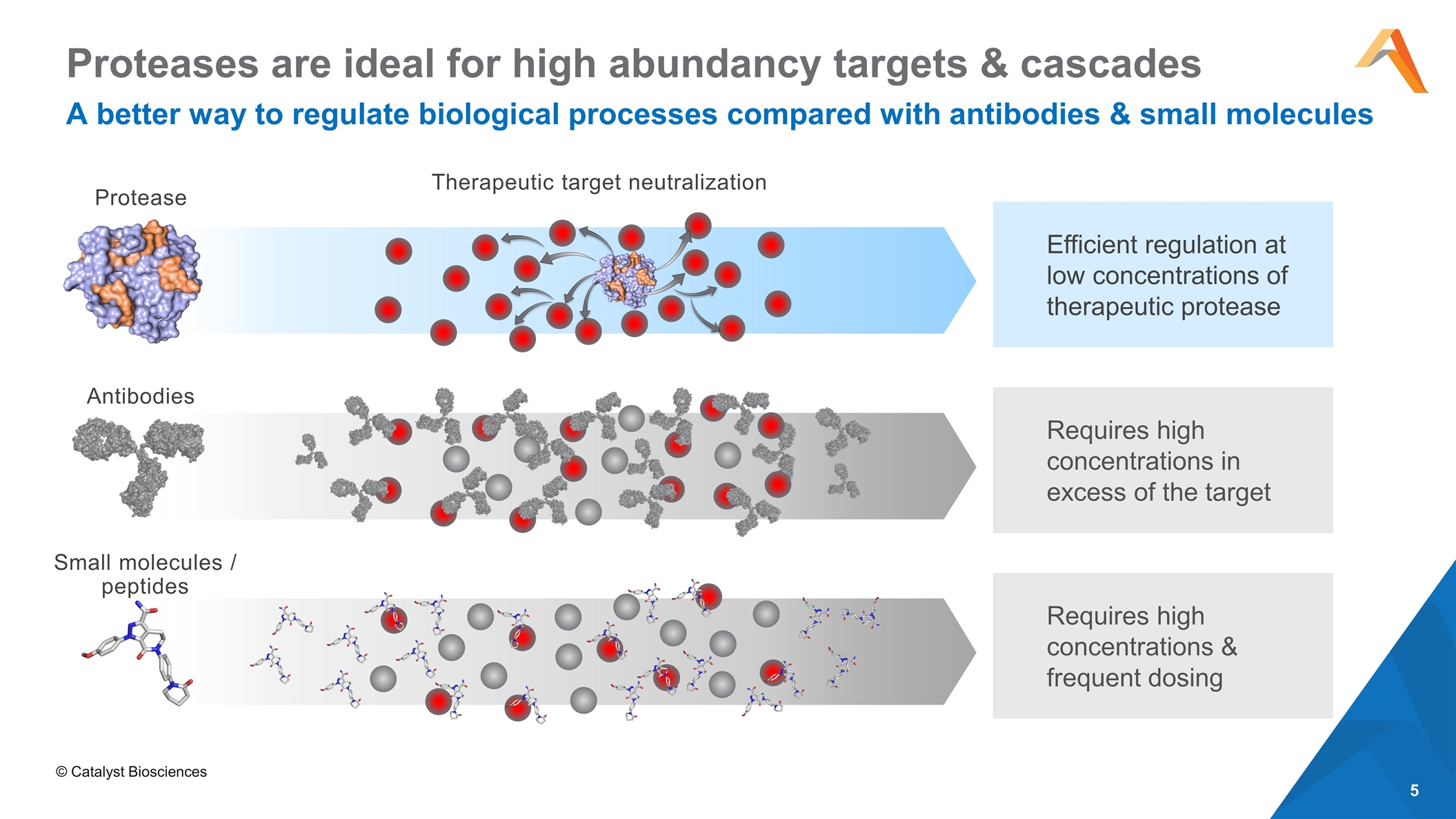
Requires high concentrations in excess of the target Requires high concentrations & frequent dosing Efficient regulation at low concentrations of therapeutic protease Proteases are ideal for high abundancy targets & cascades A better way to regulate biological processes compared with antibodies & small molecules Antibodies Small molecules / peptides Therapeutic target neutralization © Catalyst Biosciences Protease
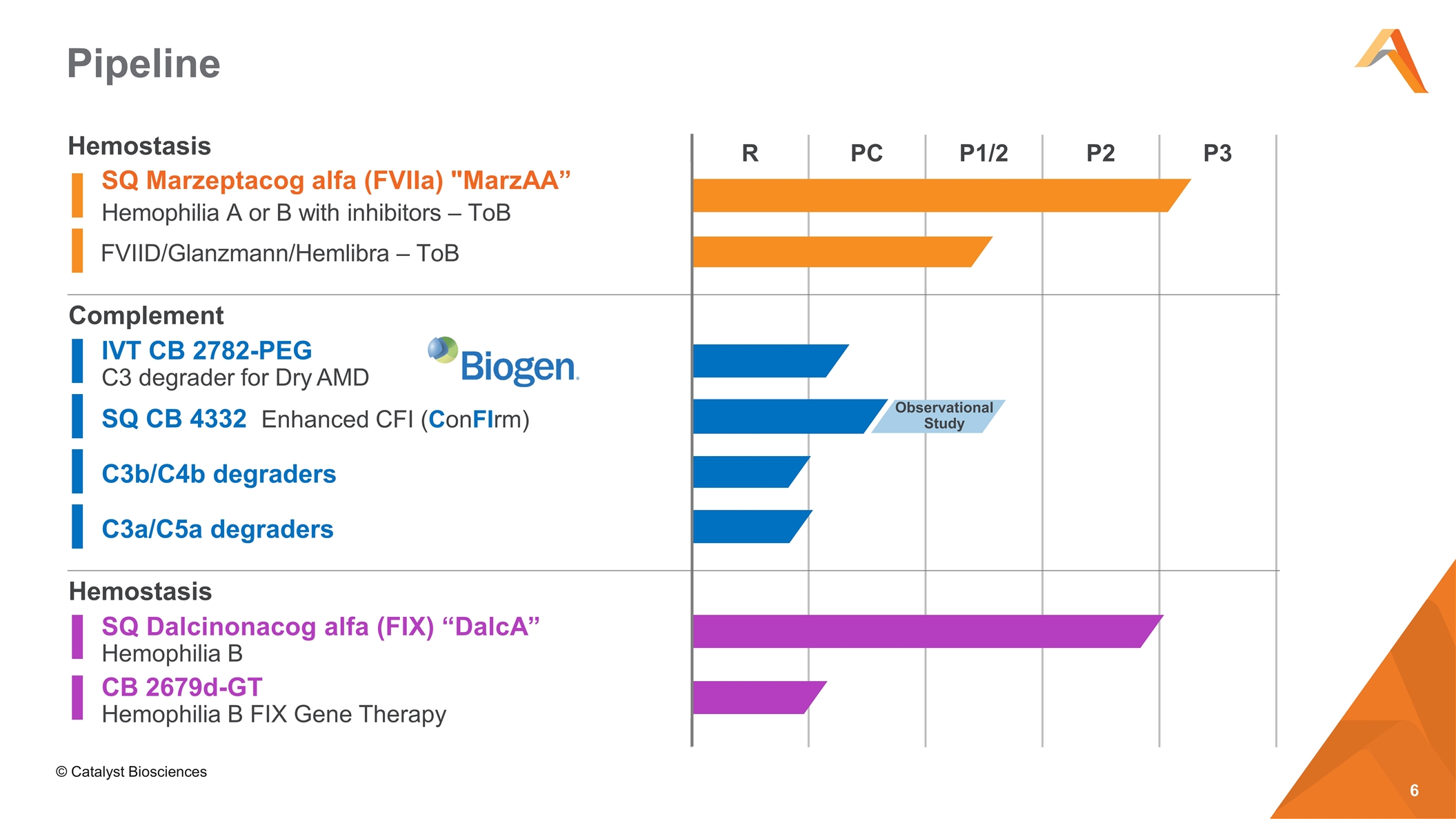
R PC P1/2 P2 P3 Pipeline Hemostasis SQ Marzeptacog alfa (FVIIa) "MarzAA” Hemophilia A or B with inhibitors – ToB FVIID/Glanzmann/Hemlibra – ToB Complement IVT CB 2782-PEG C3 degrader for Dry AMD SQ CB 4332 Enhanced CFI (ConFIrm) C3b/C4b degraders C3a/C5a degraders Hemostasis SQ Dalcinonacog alfa (FIX) “DalcA” Hemophilia B CB 2679d-GT Hemophilia B FIX Gene Therapy © Catalyst Biosciences Observational Study
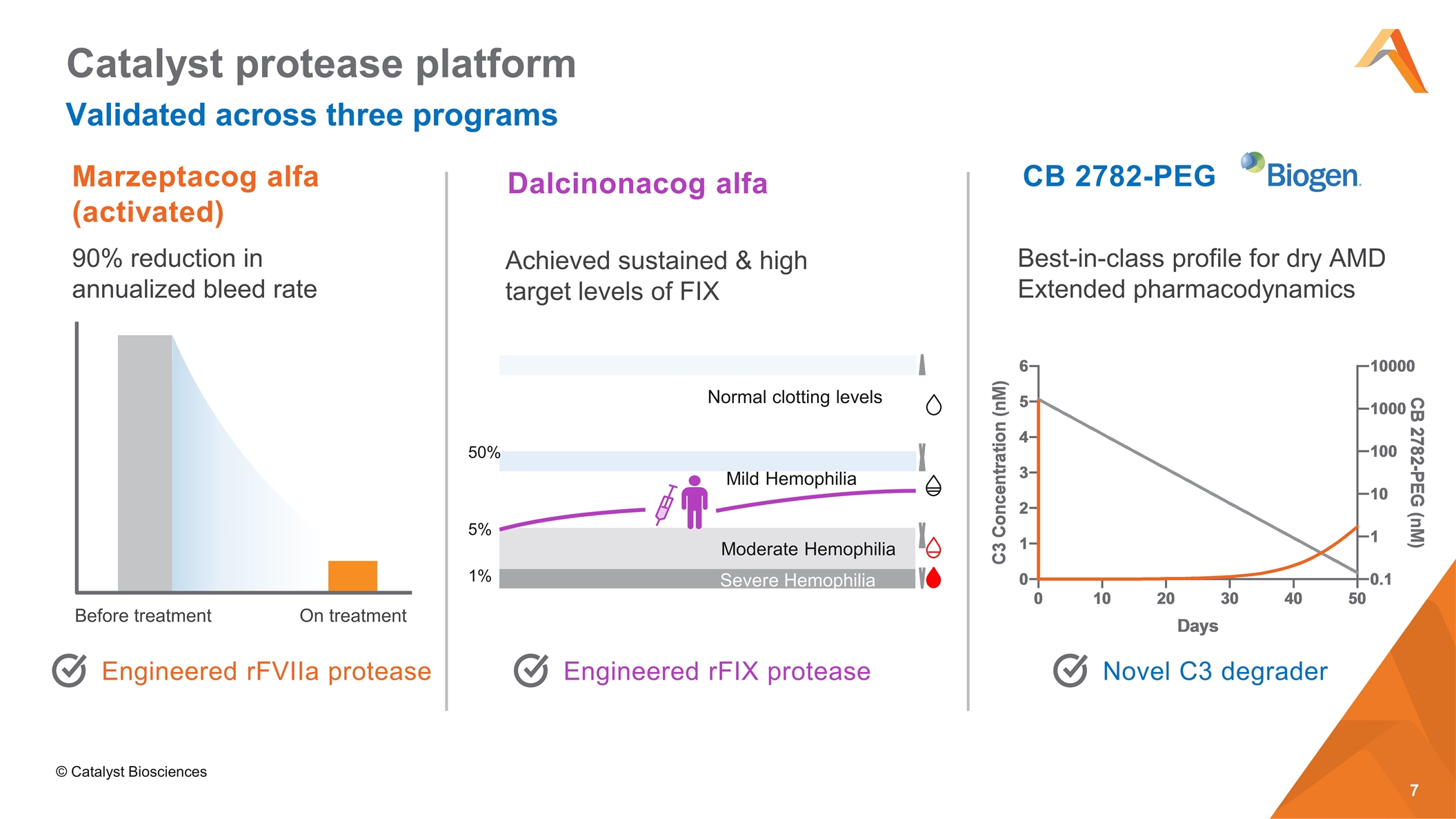
Validated across three programs Catalyst protease platform Before treatment On treatment Marzeptacog alfa (activated) Dalcinonacog alfa CB 2782-PEG Engineered rFVIIa protease 90% reduction in annualized bleed rate Achieved sustained & high target levels of FIX Best-in-class profile for dry AMD Extended pharmacodynamics Engineered rFIX protease Novel C3 degrader 50% 5% 1% Mild Hemophilia Normal clotting levels Severe Hemophilia Moderate Hemophilia © Catalyst Biosciences
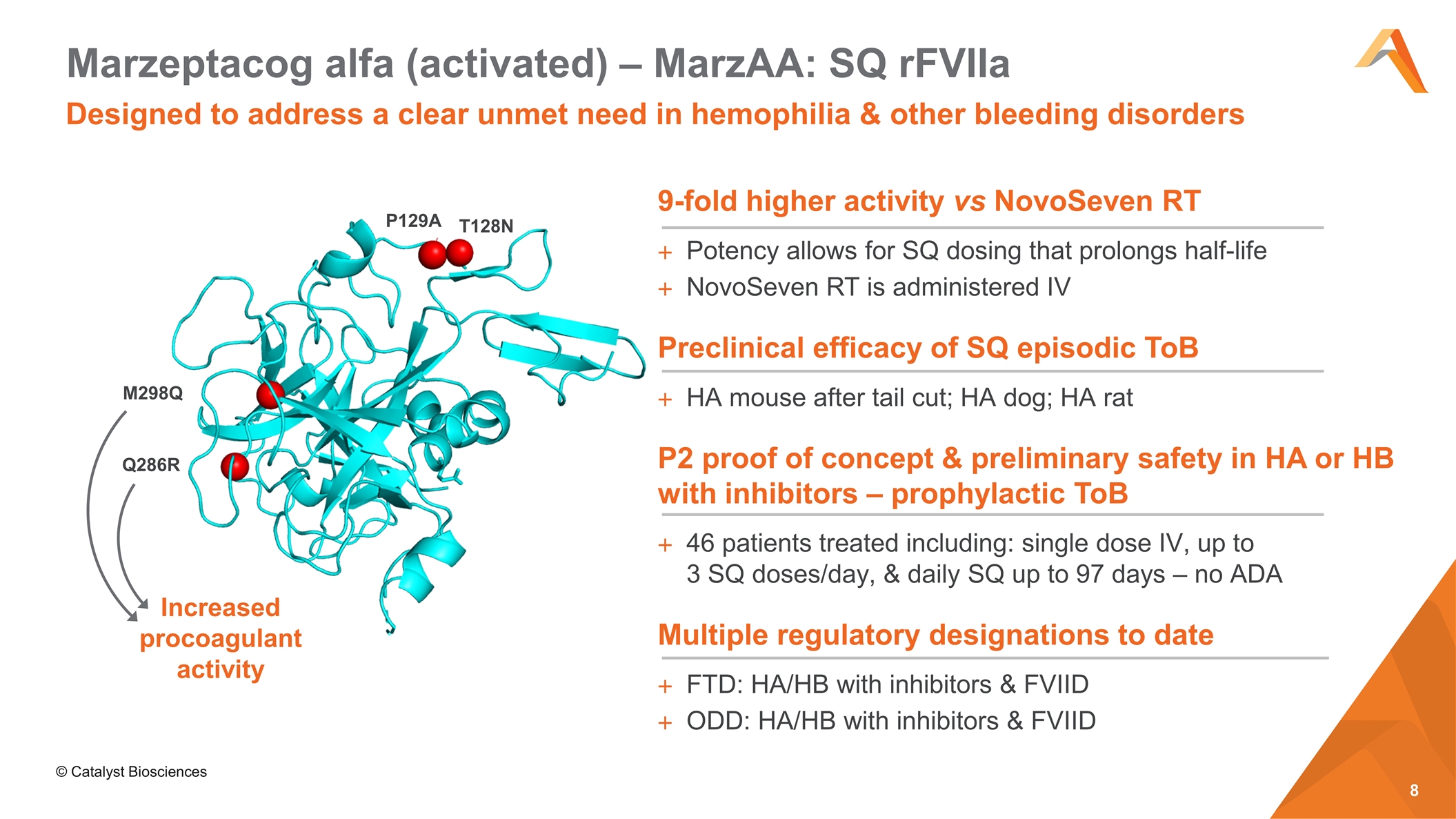
Designed to address a clear unmet need in hemophilia & other bleeding disorders Marzeptacog alfa (activated) – MarzAA: SQ rFVIIa 9-fold higher activity vs NovoSeven RT Potency allows for SQ dosing that prolongs half-life NovoSeven RT is administered IV Preclinical efficacy of SQ episodic ToB HA mouse after tail cut; HA dog; HA rat P2 proof of concept & preliminary safety in HA or HB with inhibitors – prophylactic ToB 46 patients treated including: single dose IV, up to 3 SQ doses/day, & daily SQ up to 97 days – no ADA Multiple regulatory designations to date FTD: HA/HB with inhibitors & FVIID ODD: HA/HB with inhibitors & FVIID P129A M298Q T128N Increased procoagulant activity Q286R © Catalyst Biosciences
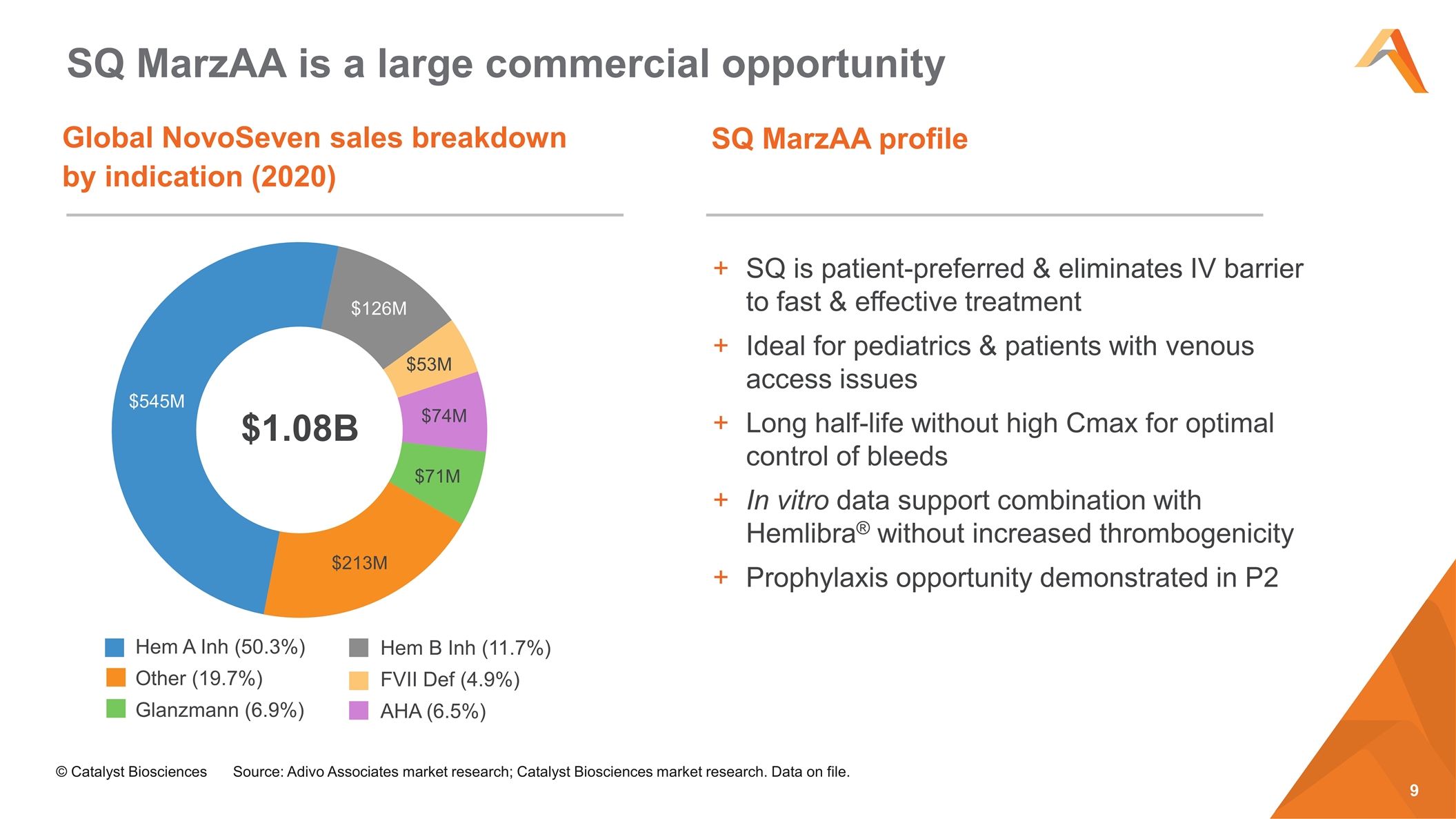
SQ MarzAA is a large commercial opportunity Global NovoSeven sales breakdown by indication (2020) Hem A Inh (50.3%) Other (19.7%) Glanzmann (6.9%) Source: Adivo Associates market research; Catalyst Biosciences market research. Data on file. Hem B Inh (11.7%) FVII Def (4.9%) AHA (6.5%) SQ is patient-preferred & eliminates IV barrier to fast & effective treatment Ideal for pediatrics & patients with venous access issues Long half-life without high Cmax for optimal control of bleeds In vitro data support combination with Hemlibra® without increased thrombogenicity Prophylaxis opportunity demonstrated in P2 SQ MarzAA profile © Catalyst Biosciences
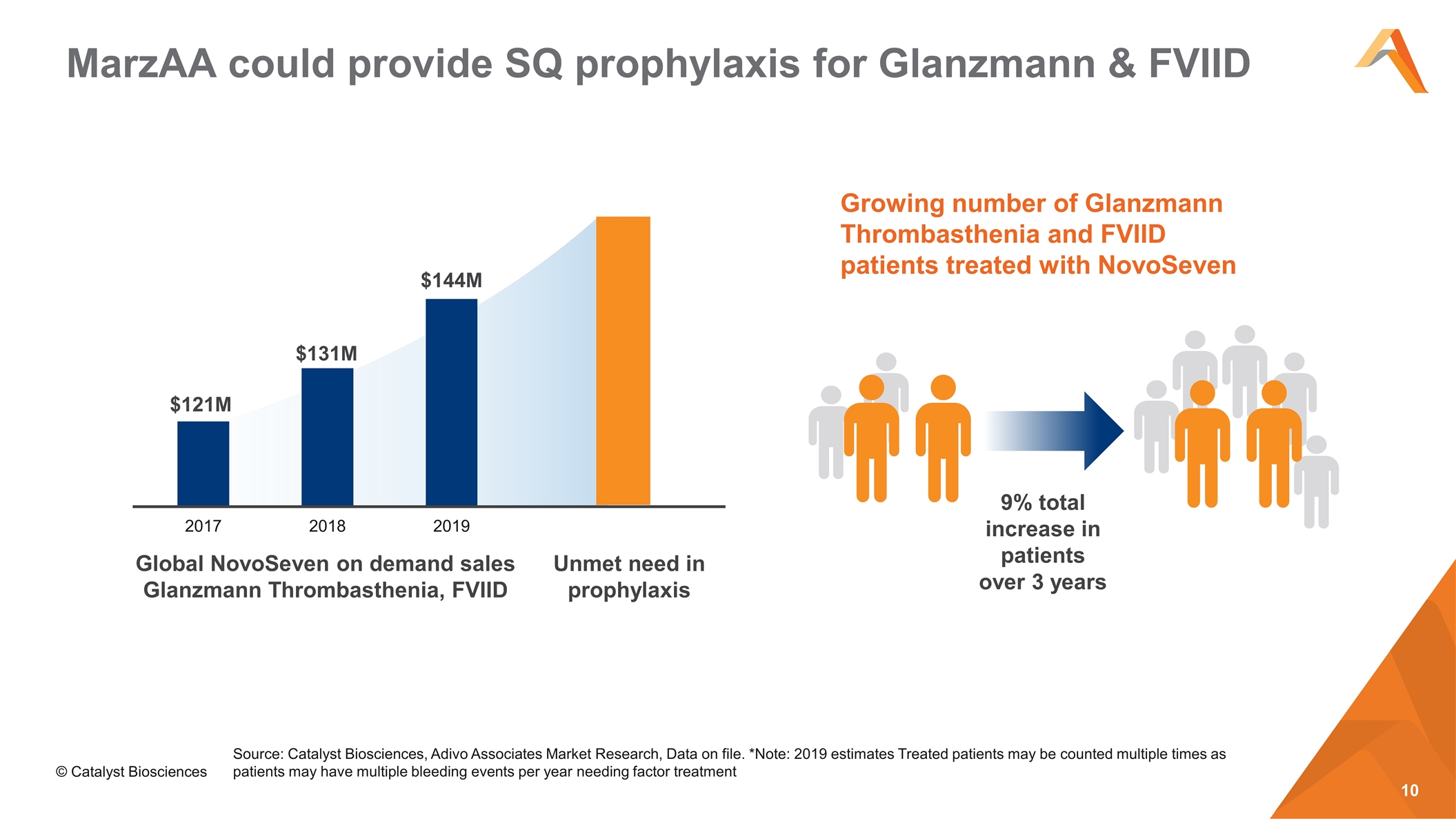
MarzAA could provide SQ prophylaxis for Glanzmann & FVIID Global NovoSeven on demand sales Glanzmann Thrombasthenia, FVIID Unmet need in prophylaxis Growing number of Glanzmann Thrombasthenia and FVIID patients treated with NovoSeven Source: Catalyst Biosciences, Adivo Associates Market Research, Data on file. *Note: 2019 estimates Treated patients may be counted multiple times as patients may have multiple bleeding events per year needing factor treatment 9% total increase in patients over 3 years © Catalyst Biosciences
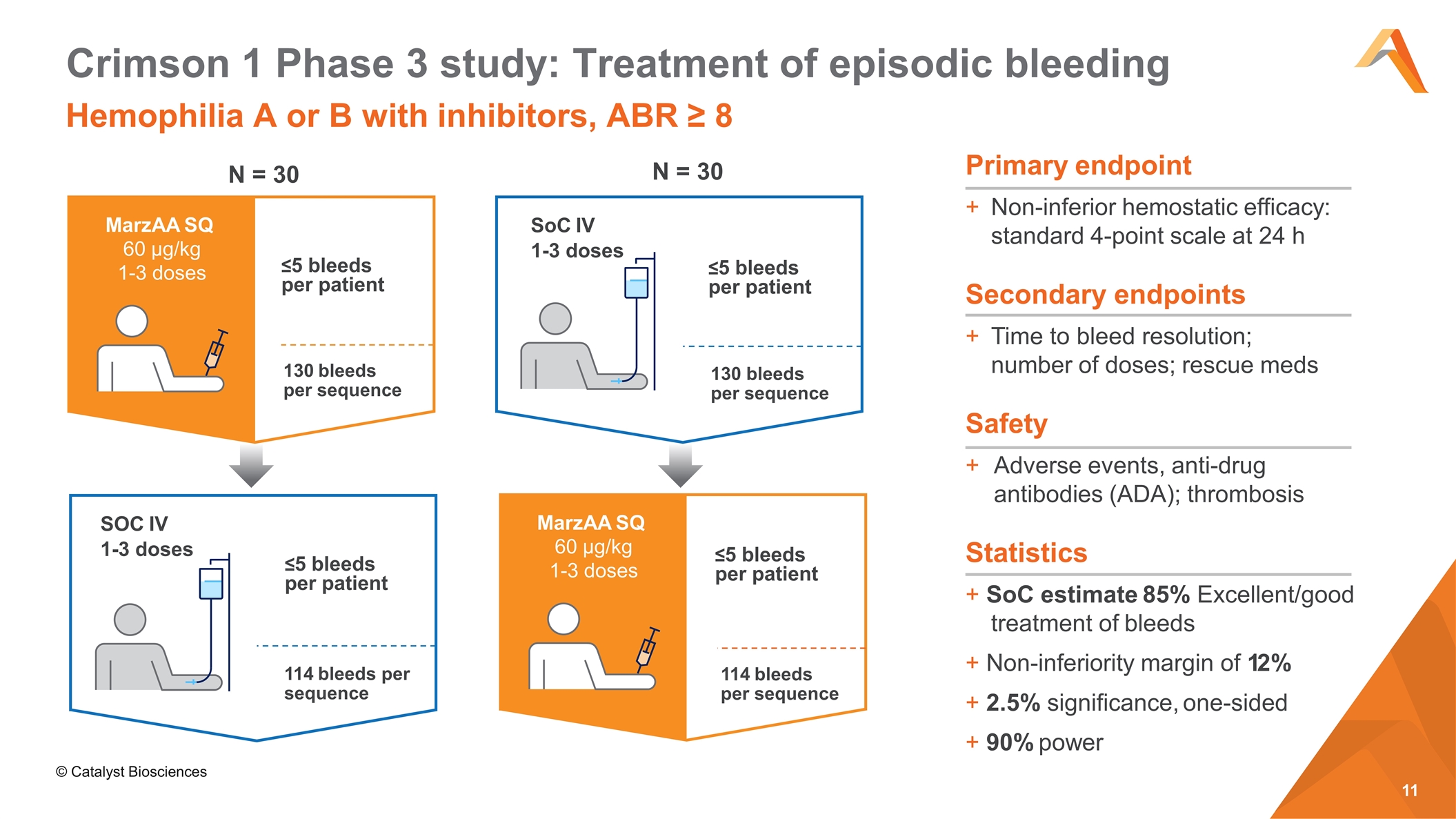
Hemophilia A or B with inhibitors, ABR ≥ 8 Crimson 1 Phase 3 study: Treatment of episodic bleeding MarzAA SQ 60 µg/kg 1-3 doses 130 bleeds per sequence ≤5 bleeds per patient N = 30 SOC IV 1-3 doses ≤5 bleeds per patient 114 bleeds per sequence MarzAA SQ 60 µg/kg 1-3 doses ≤5 bleeds per patient 114 bleeds per sequence 130 bleeds per sequence ≤5 bleeds per patient SoC IV 1-3 doses N = 30 Primary endpoint Non-inferior hemostatic efficacy: standard 4-point scale at 24 h Secondary endpoints Time to bleed resolution; number of doses; rescue meds Safety Adverse events, anti-drug antibodies (ADA); thrombosis Statistics + SoC estimate 85% Excellent/good treatment of bleeds + Non-inferiority margin of 12% + 2.5% significance, one-sided + 90% power © Catalyst Biosciences
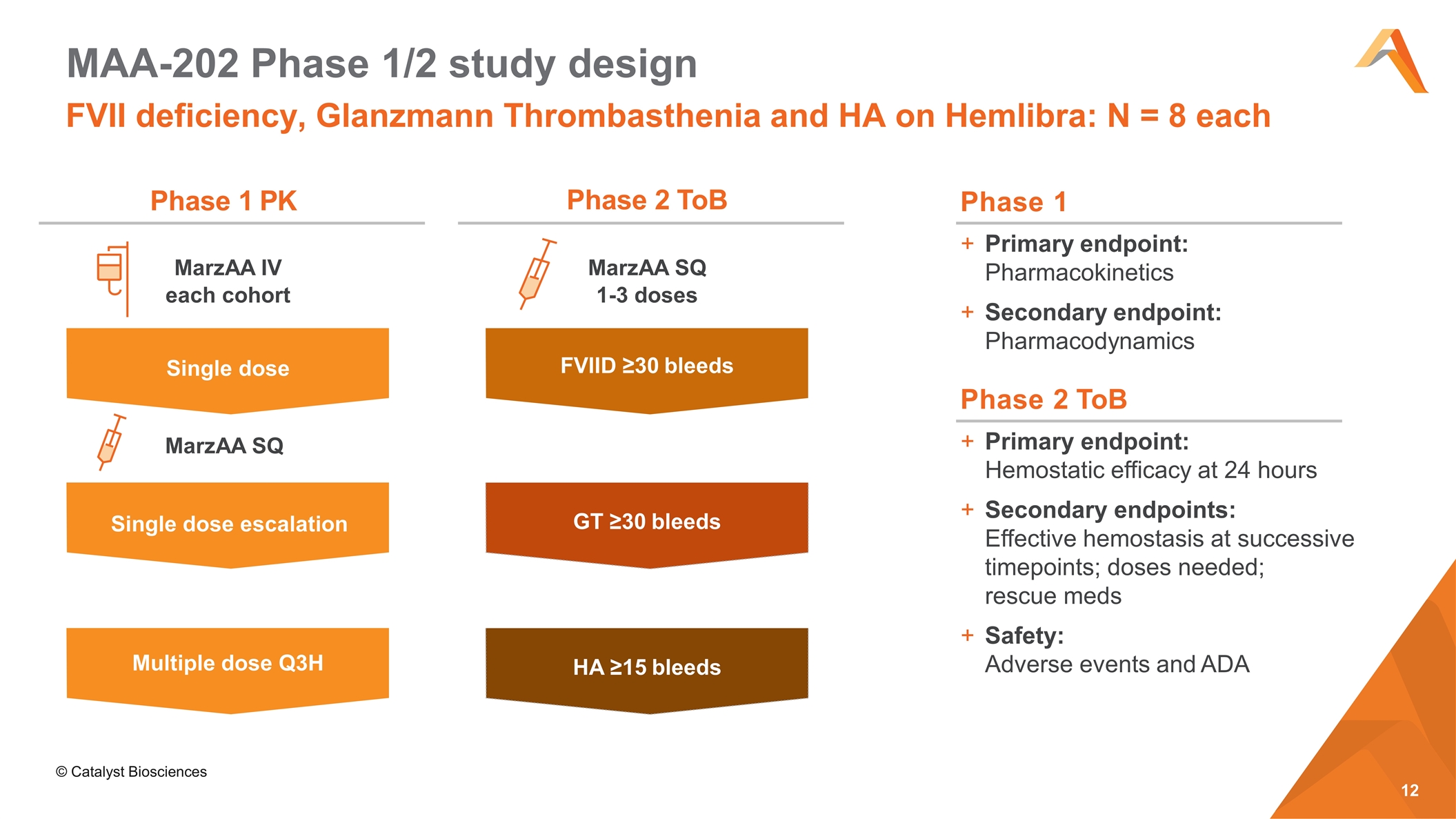
FVII deficiency, Glanzmann Thrombasthenia and HA on Hemlibra: N = 8 each MAA-202 Phase 1/2 study design Phase 1 Primary endpoint: Pharmacokinetics Secondary endpoint: Pharmacodynamics Phase 2 ToB Primary endpoint: Hemostatic efficacy at 24 hours Secondary endpoints: Effective hemostasis at successive timepoints; doses needed; rescue meds Safety: Adverse events and ADA Single dose Single dose escalation GT ≥30 bleeds FVIID ≥30 bleeds Phase 2 ToB Phase 1 PK MarzAA IV each cohort MarzAA SQ HA ≥15 bleeds MarzAA SQ 1-3 doses Multiple dose Q3H © Catalyst Biosciences
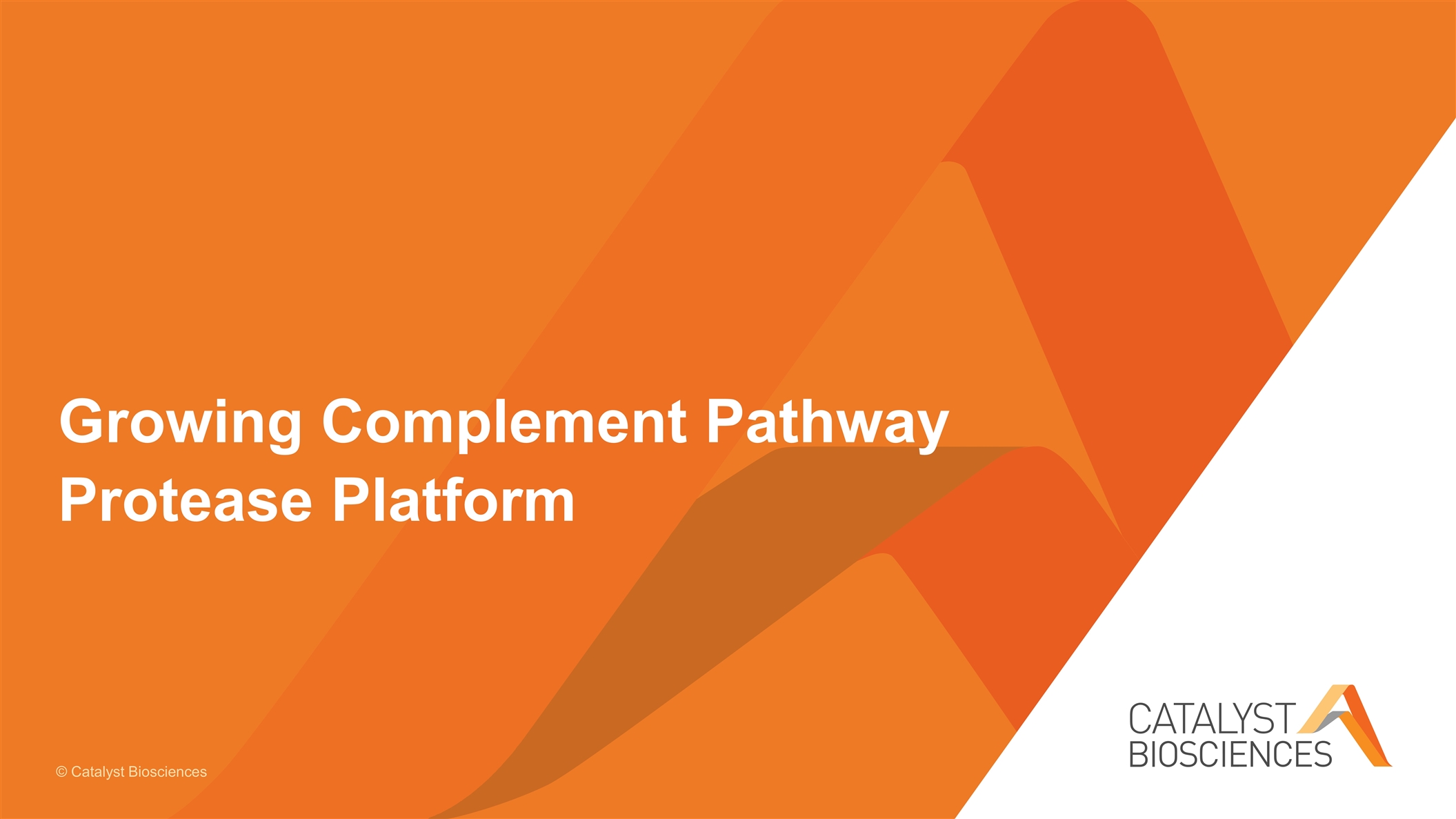
Growing Complement Pathway Protease Platform © Catalyst Biosciences
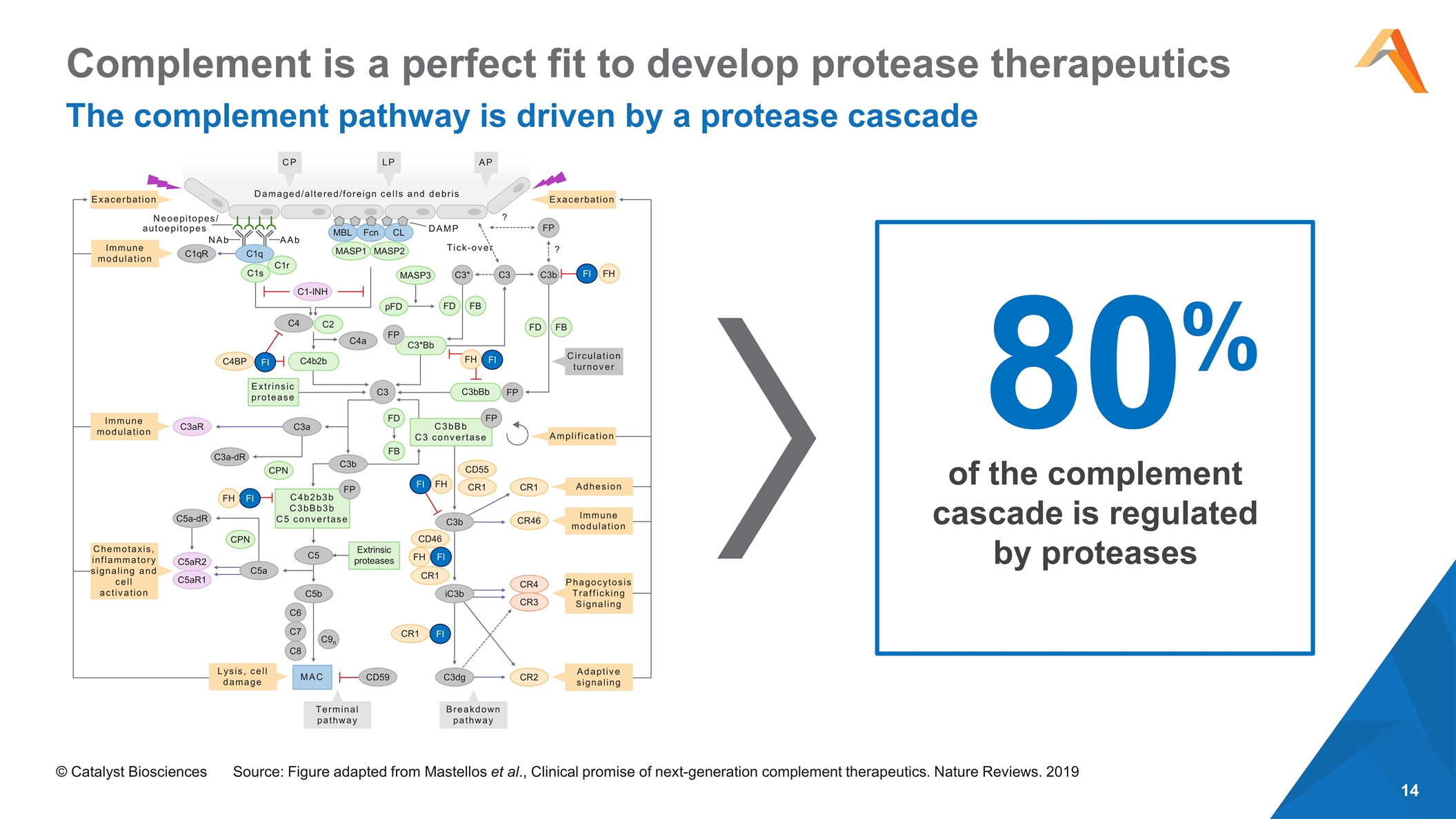
Complement is a perfect fit to develop protease therapeutics The complement pathway is driven by a protease cascade Source: Figure adapted from Mastellos et al., Clinical promise of next-generation complement therapeutics. Nature Reviews. 2019 of the complement cascade is regulated by proteases 80 % Exacerbation Immune modulation Immune modulation C1qR C3aR C1s C1r AAb NAb Neoepitopes/ autoepitopes Damaged/altered/foreign cells and debris C1-INH C2 C4 C4a C4b2b C3 Extrinsic protease C3a C3a-dR CPN C3b C4b2b3b C3bBb3b C5 convertase C5 C5b C5a Chemotaxis, inflammatory signaling and cell activation C5aR2 C5aR1 C5a-dR CPN MAC C6 C7 C8 C9n Extrinsic proteases CD59 MBL Fcn CL MASP1 MASP2 C1q Tick-over C3*Bb C3bBb pFD FP FP FD FB FH FP MASP3 C3* C3 C3b FP ? ? FB FD C3bBb C3 convertase FP FD FB FH CD55 CR1 C3b iC3b CD46 FH FI CR1 C3dg FI CR1 CR2 CR4 CR3 CR1 CR46 Exacerbation DAMP Amplification Immune modulation Adhesion Phagocytosis Trafficking Signaling Adaptive signaling Lysis, cell damage Terminal pathway Breakdown pathway CP LP AP Circulation turnover FI FI C4BP FI FH FI FI FH © Catalyst Biosciences
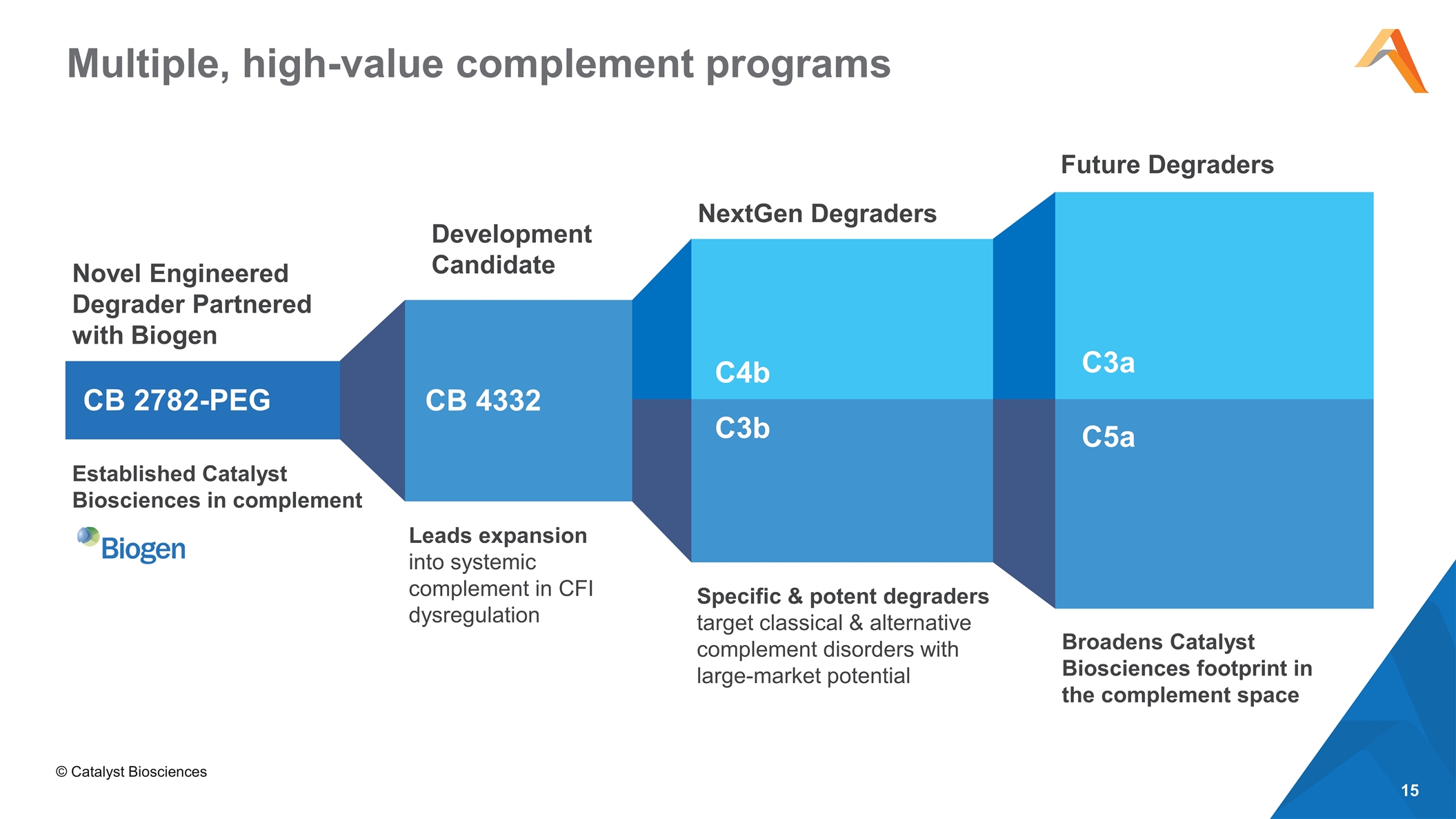
© Catalyst Biosciences Multiple, high-value complement programs CB 4332 C4b C3a CB 2782-PEG C3b C5a NextGen Degraders Future Degraders Development Candidate Novel Engineered Degrader Partnered with Biogen Established Catalyst Biosciences in complement Leads expansion into systemic complement in CFI dysregulation Specific & potent degraders target classical & alternative complement disorders with large-market potential Broadens Catalyst Biosciences footprint in the complement space
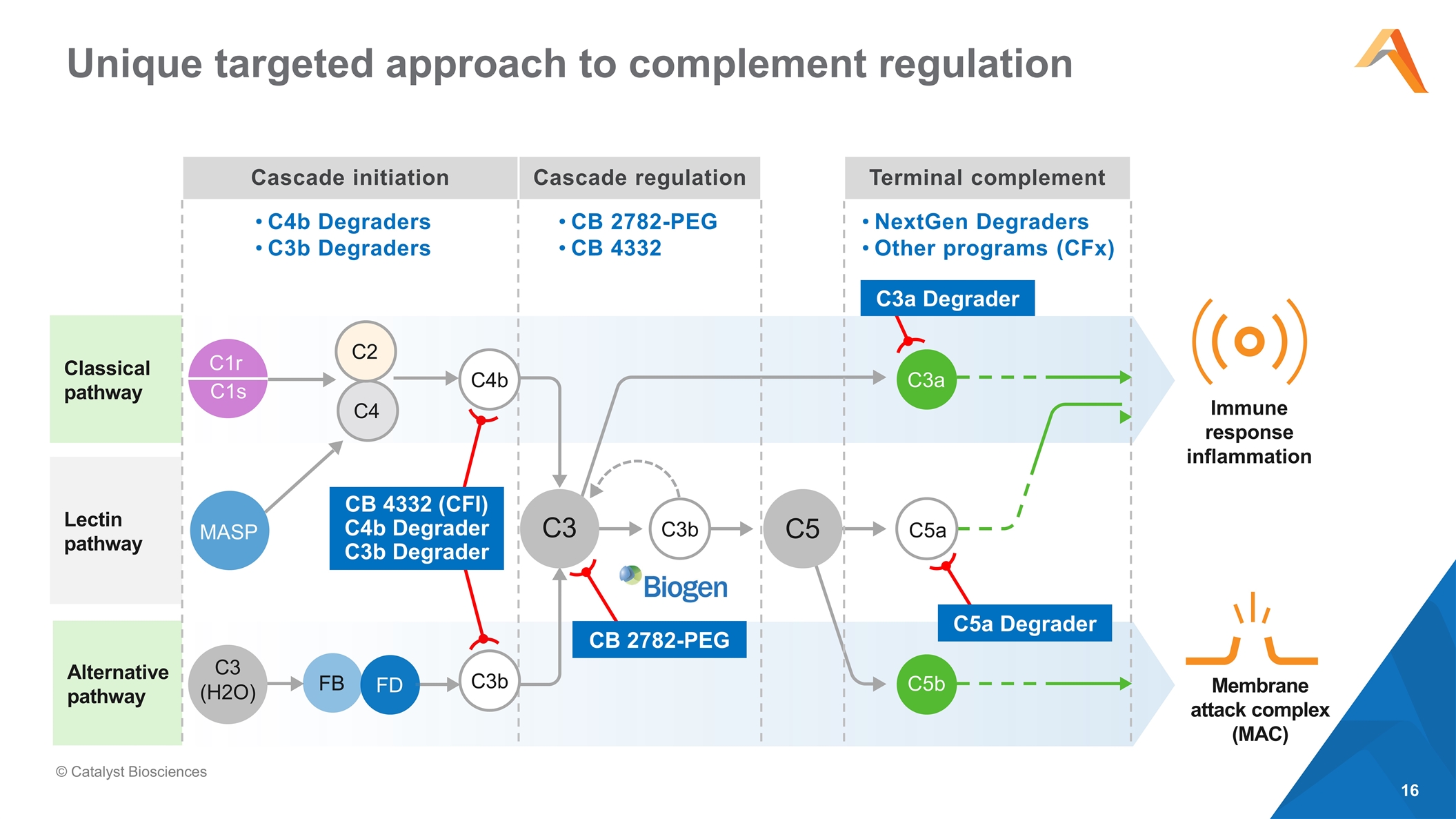
© Catalyst Biosciences Unique targeted approach to complement regulation Classical pathway Lectin pathway Alternative pathway Membrane attack complex (MAC) Immune response inflammation C3a C5a C5b C3 C5 CB 2782-PEG MASP C4 C2 C1r C1s C3b FD FB CB 4332 (CFI) C4b Degrader C3b Degrader FD FB Cascade initiation Cascade regulation Terminal complement C5a Degrader C3a Degrader C4b Degraders C3b Degraders NextGen Degraders Other programs (CFx) CB 2782-PEG CB 4332 C3 (H2O) C3b C4b C3b
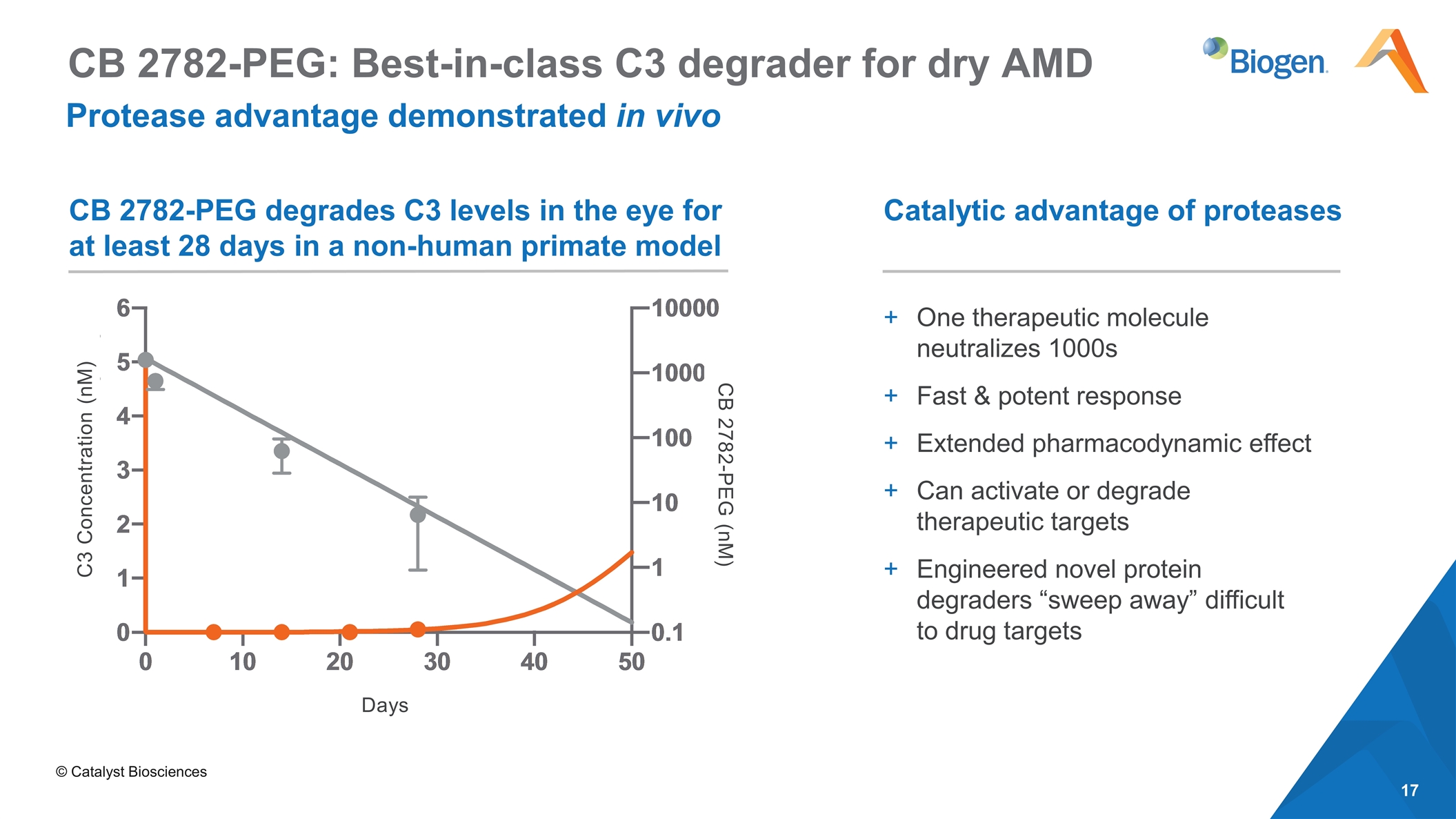
CB 2782-PEG: Best-in-class C3 degrader for dry AMD Protease advantage demonstrated in vivo CB 2782-PEG degrades C3 levels in the eye for at least 28 days in a non-human primate model Catalytic advantage of proteases One therapeutic molecule neutralizes 1000s Fast & potent response Extended pharmacodynamic effect Can activate or degrade therapeutic targets Engineered novel protein degraders “sweep away” difficult to drug targets CB 2782-PEG (nM) Days C3 Concentration (nM) © Catalyst Biosciences
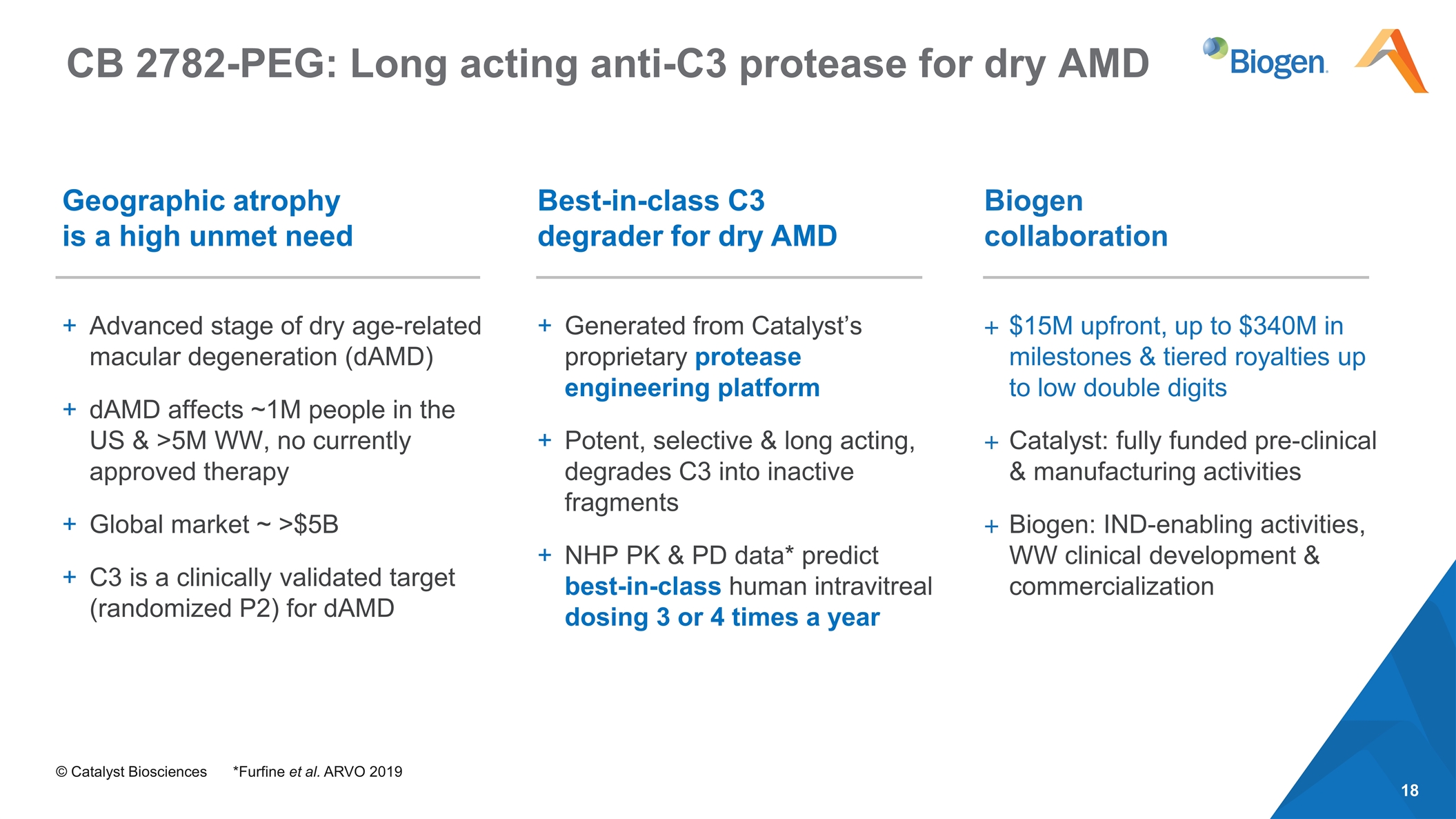
© Catalyst Biosciences CB 2782-PEG: Long acting anti-C3 protease for dry AMD *Furfine et al. ARVO 2019 Geographic atrophy is a high unmet need Advanced stage of dry age-related macular degeneration (dAMD) dAMD affects ~1M people in the US & >5M WW, no currently approved therapy Global market ~ >$5B C3 is a clinically validated target (randomized P2) for dAMD Best-in-class C3 degrader for dry AMD Generated from Catalyst’s proprietary protease engineering platform Potent, selective & long acting, degrades C3 into inactive fragments NHP PK & PD data* predict best-in-class human intravitreal dosing 3 or 4 times a year Biogen collaboration $15M upfront, up to $340M in milestones & tiered royalties up to low double digits Catalyst: fully funded pre-clinical & manufacturing activities Biogen: IND-enabling activities, WW clinical development & commercialization
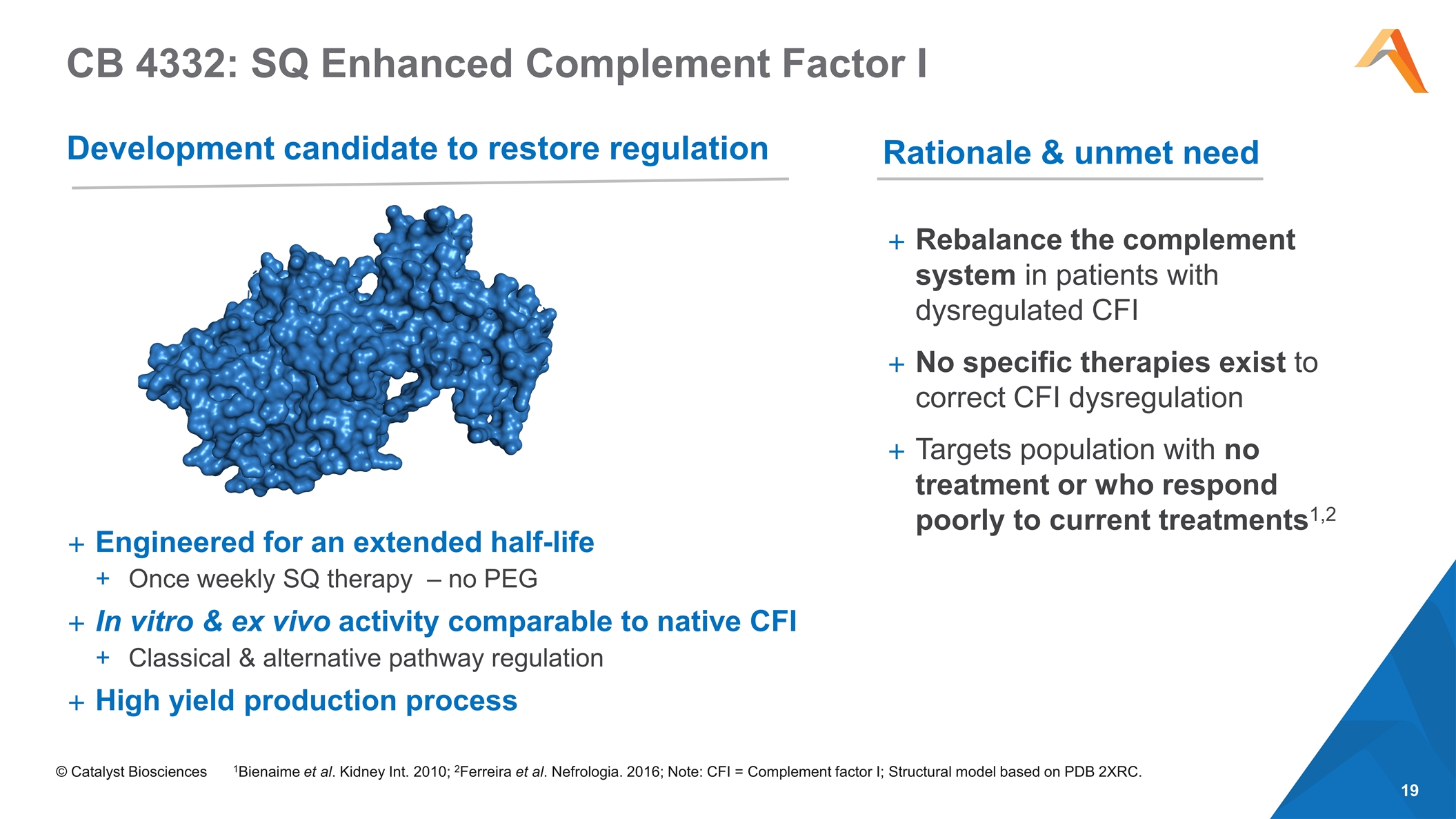
© Catalyst Biosciences CB 4332: SQ Enhanced Complement Factor I Development candidate to restore regulation 1Bienaime et al. Kidney Int. 2010; 2Ferreira et al. Nefrologia. 2016; Note: CFI = Complement factor I; Structural model based on PDB 2XRC. Engineered for an extended half-life Once weekly SQ therapy – no PEG In vitro & ex vivo activity comparable to native CFI Classical & alternative pathway regulation High yield production process Rebalance the complement system in patients with dysregulated CFI No specific therapies exist to correct CFI dysregulation Targets population with no treatment or who respond poorly to current treatments1,2 Rationale & unmet need
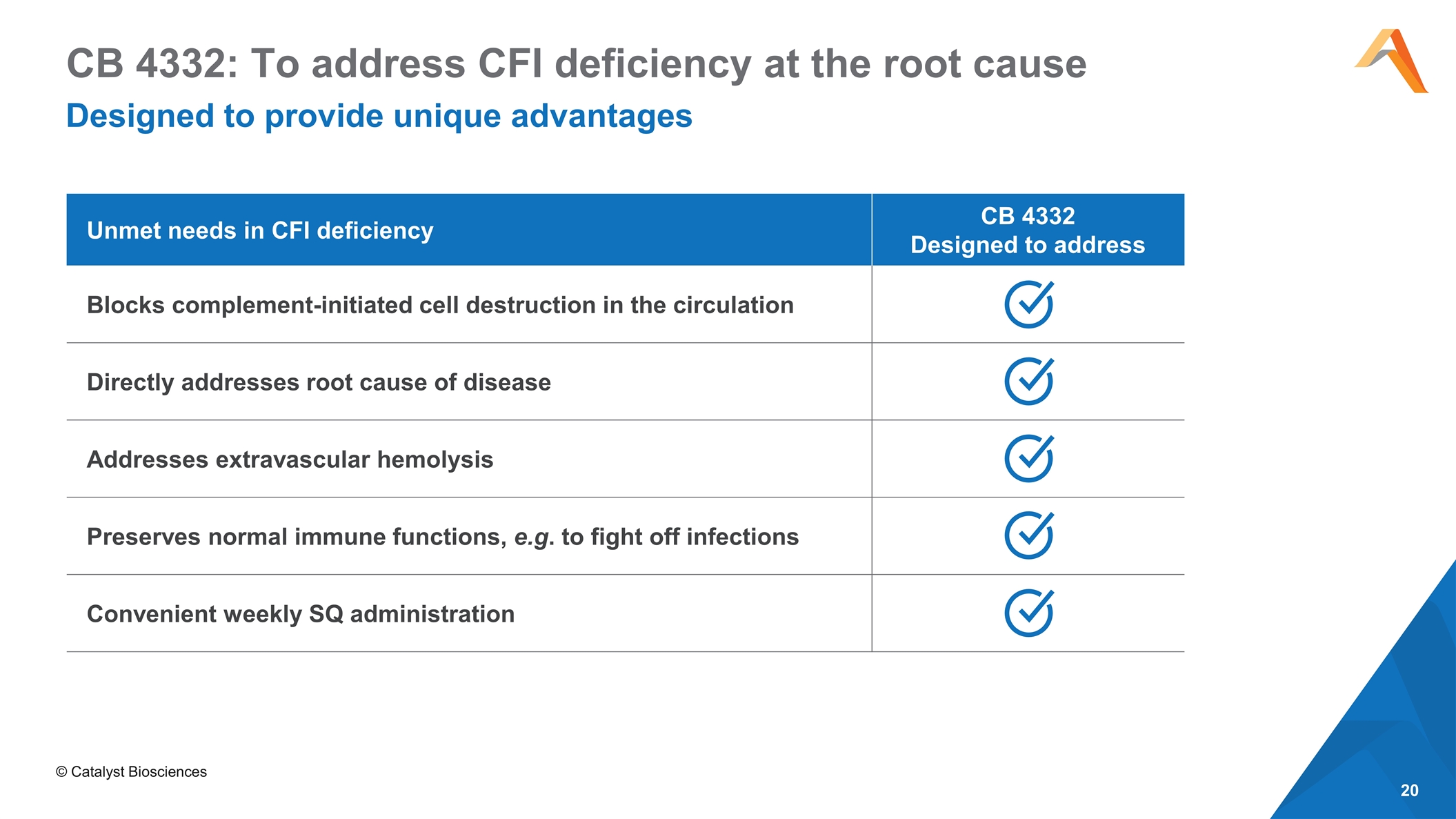
CB 4332: To address CFI deficiency at the root cause Designed to provide unique advantages Unmet needs in CFI deficiency CB 4332 Designed to address Blocks complement-initiated cell destruction in the circulation Directly addresses root cause of disease Addresses extravascular hemolysis Preserves normal immune functions, e.g. to fight off infections Convenient weekly SQ administration © Catalyst Biosciences
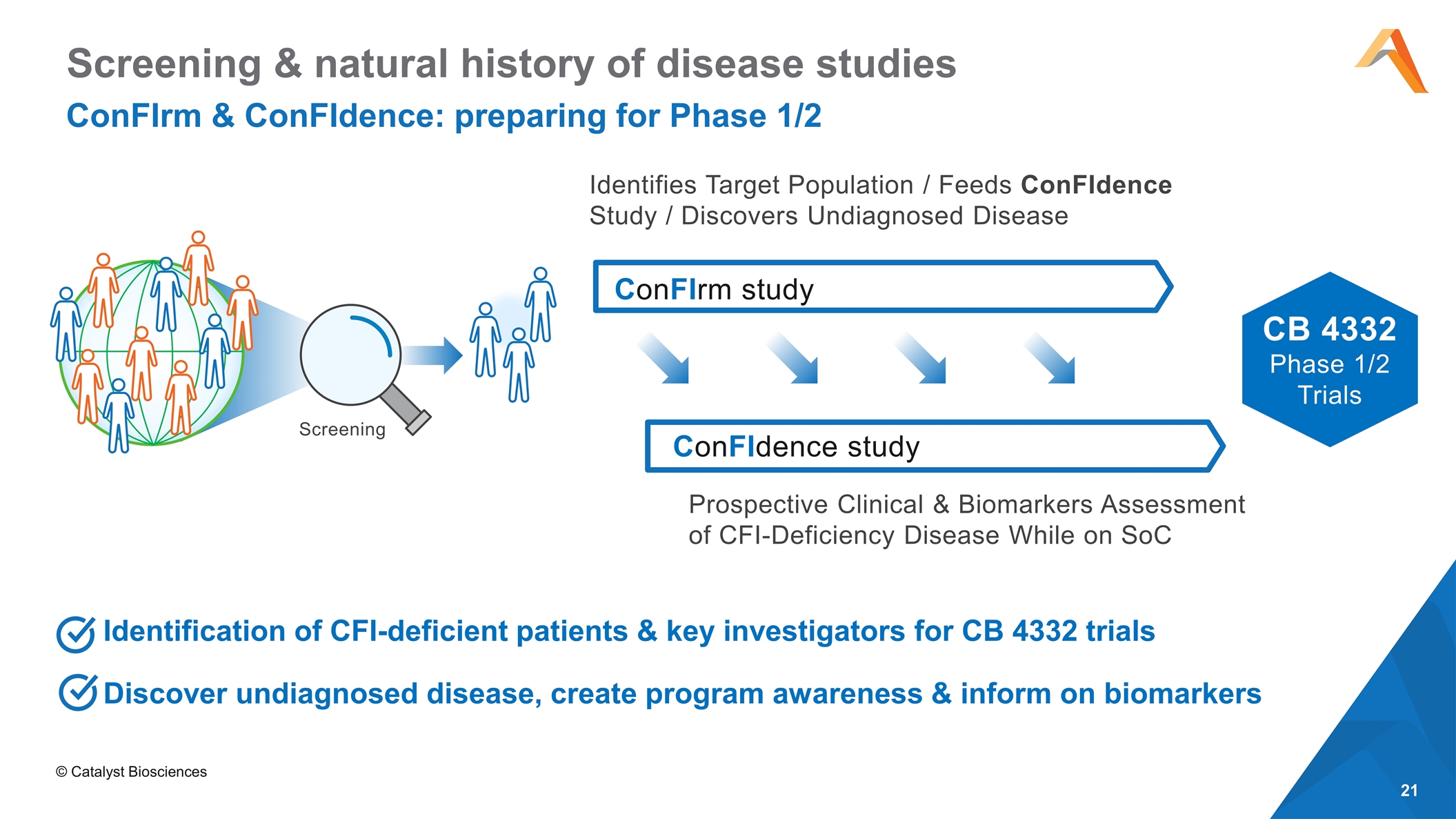
CB 4332 Phase 1/2 Trials Screening Screening & natural history of disease studies ConFIrm & ConFIdence: preparing for Phase 1/2 Identifies Target Population / Feeds ConFIdence Study / Discovers Undiagnosed Disease Prospective Clinical & Biomarkers Assessment of CFI-Deficiency Disease While on SoC Screening Identification of CFI-deficient patients & key investigators for CB 4332 trials Discover undiagnosed disease, create program awareness & inform on biomarkers CB 4332 Phase 1/2 Trials ConFIrm study ConFIdence study CB 4332 Phase 1/2 Trials © Catalyst Biosciences
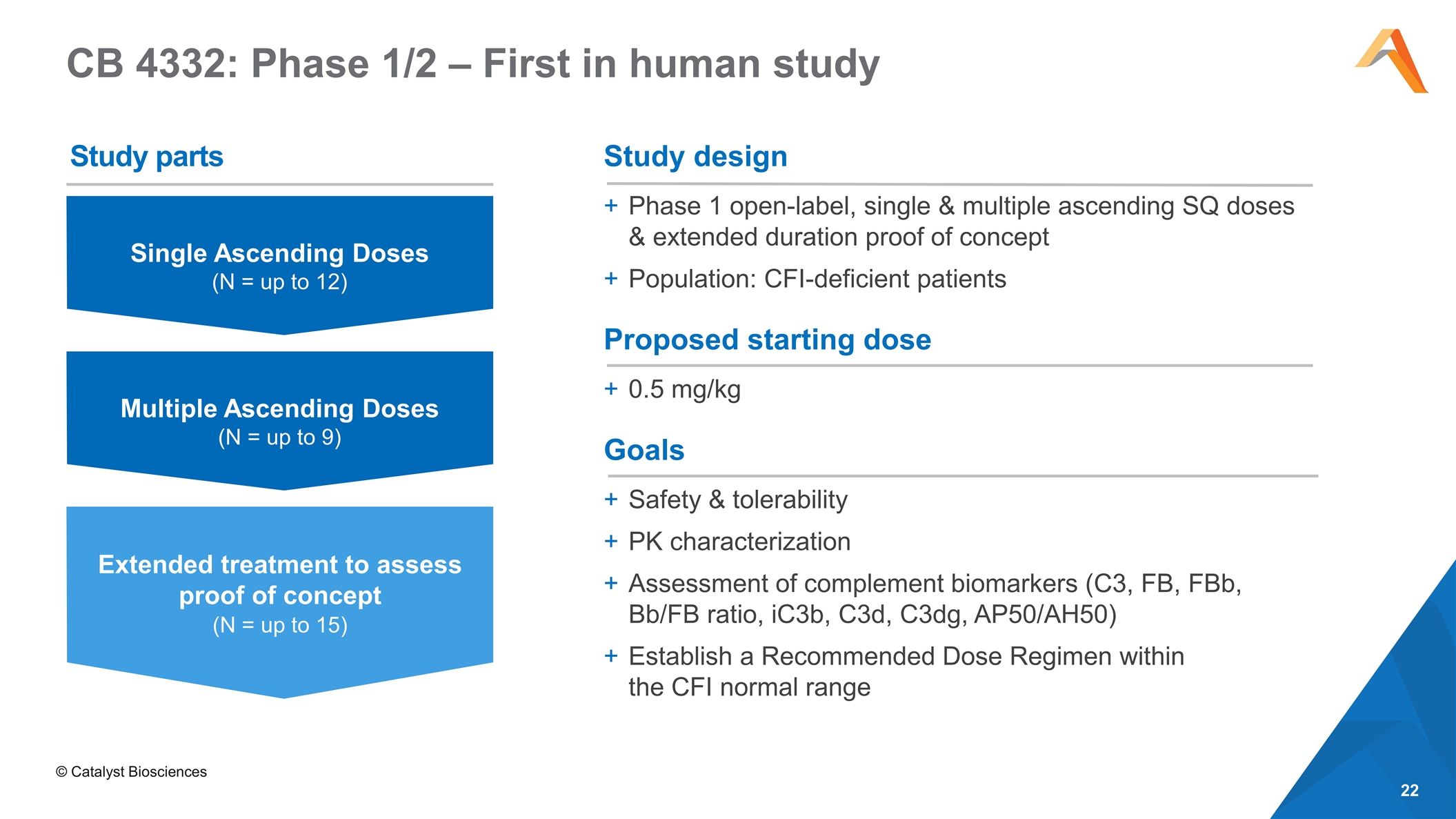
CB 4332: Phase 1/2 – First in human study Extended treatment to assess proof of concept (N = up to 15) Study parts Multiple Ascending Doses (N = up to 9) Single Ascending Doses (N = up to 12) Study design Phase 1 open-label, single & multiple ascending SQ doses & extended duration proof of concept Population: CFI-deficient patients Proposed starting dose 0.5 mg/kg Goals Safety & tolerability PK characterization Assessment of complement biomarkers (C3, FB, FBb, Bb/FB ratio, iC3b, C3d, C3dg, AP50/AH50) Establish a Recommended Dose Regimen within the CFI normal range © Catalyst Biosciences
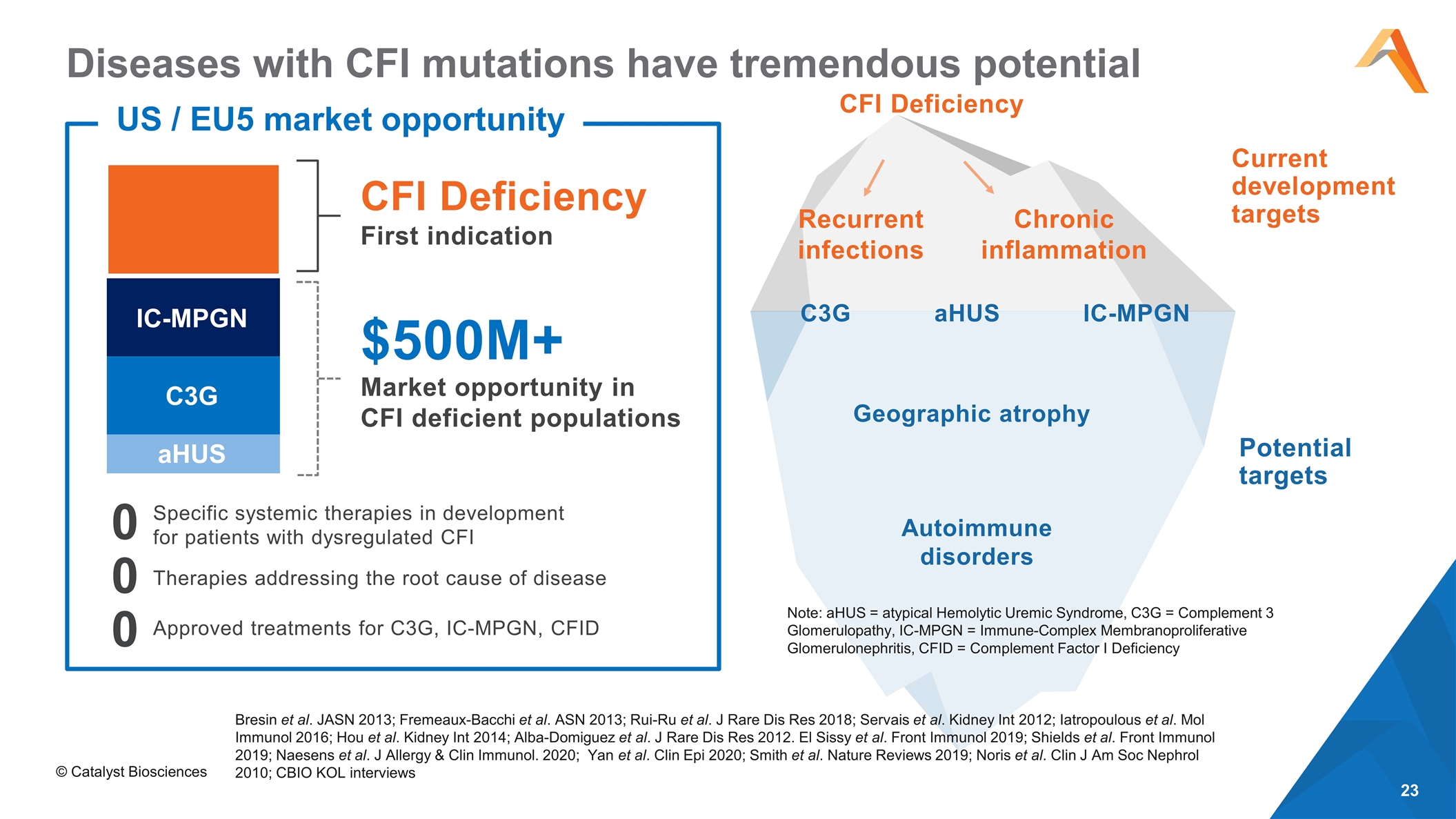
Diseases with CFI mutations have tremendous potential aHUS C3G IC-MPGN Geographic atrophy CFI Deficiency Current development targets Potential targets Chronic inflammation Recurrent infections Autoimmune disorders aHUS C3G IC-MPGN US / EU5 market opportunity Market opportunity in CFI deficient populations $500M+ CFI Deficiency First indication 0 0 0 Specific systemic therapies in development for patients with dysregulated CFI Therapies addressing the root cause of disease Approved treatments for C3G, IC-MPGN, CFID © Catalyst Biosciences Bresin et al. JASN 2013; Fremeaux-Bacchi et al. ASN 2013; Rui-Ru et al. J Rare Dis Res 2018; Servais et al. Kidney Int 2012; Iatropoulous et al. Mol Immunol 2016; Hou et al. Kidney Int 2014; Alba-Domiguez et al. J Rare Dis Res 2012. El Sissy et al. Front Immunol 2019; Shields et al. Front Immunol 2019; Naesens et al. J Allergy & Clin Immunol. 2020; Yan et al. Clin Epi 2020; Smith et al. Nature Reviews 2019; Noris et al. Clin J Am Soc Nephrol 2010; CBIO KOL interviews Note: aHUS = atypical Hemolytic Uremic Syndrome, C3G = Complement 3 Glomerulopathy, IC-MPGN = Immune-Complex Membranoproliferative Glomerulonephritis, CFID = Complement Factor I Deficiency
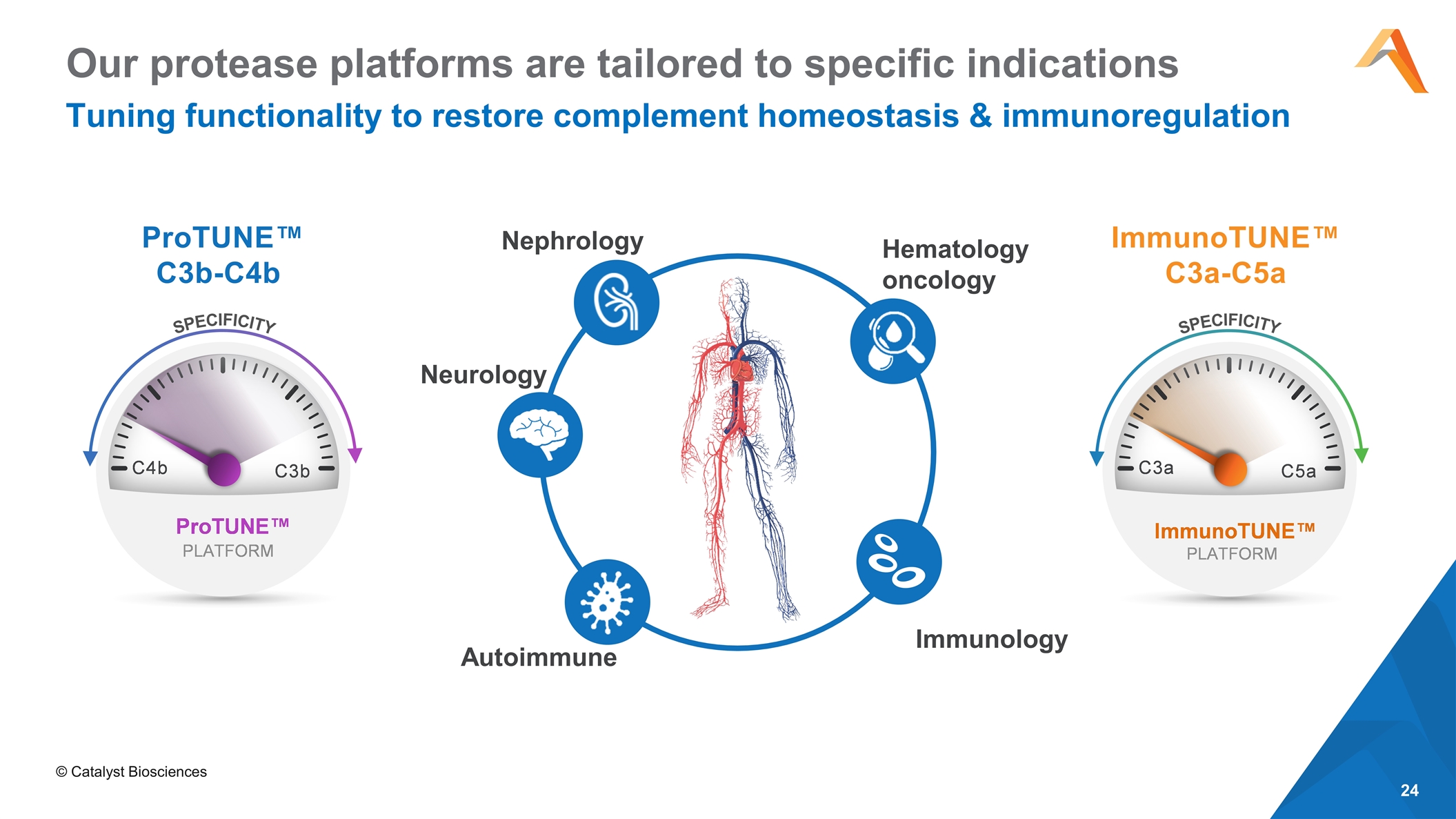
Our protease platforms are tailored to specific indications Tuning functionality to restore complement homeostasis & immunoregulation ImmunoTUNE™ C3a-C5a ProTUNE™ C3b-C4b Nephrology Hematology oncology Neurology Immunology Autoimmune © Catalyst Biosciences
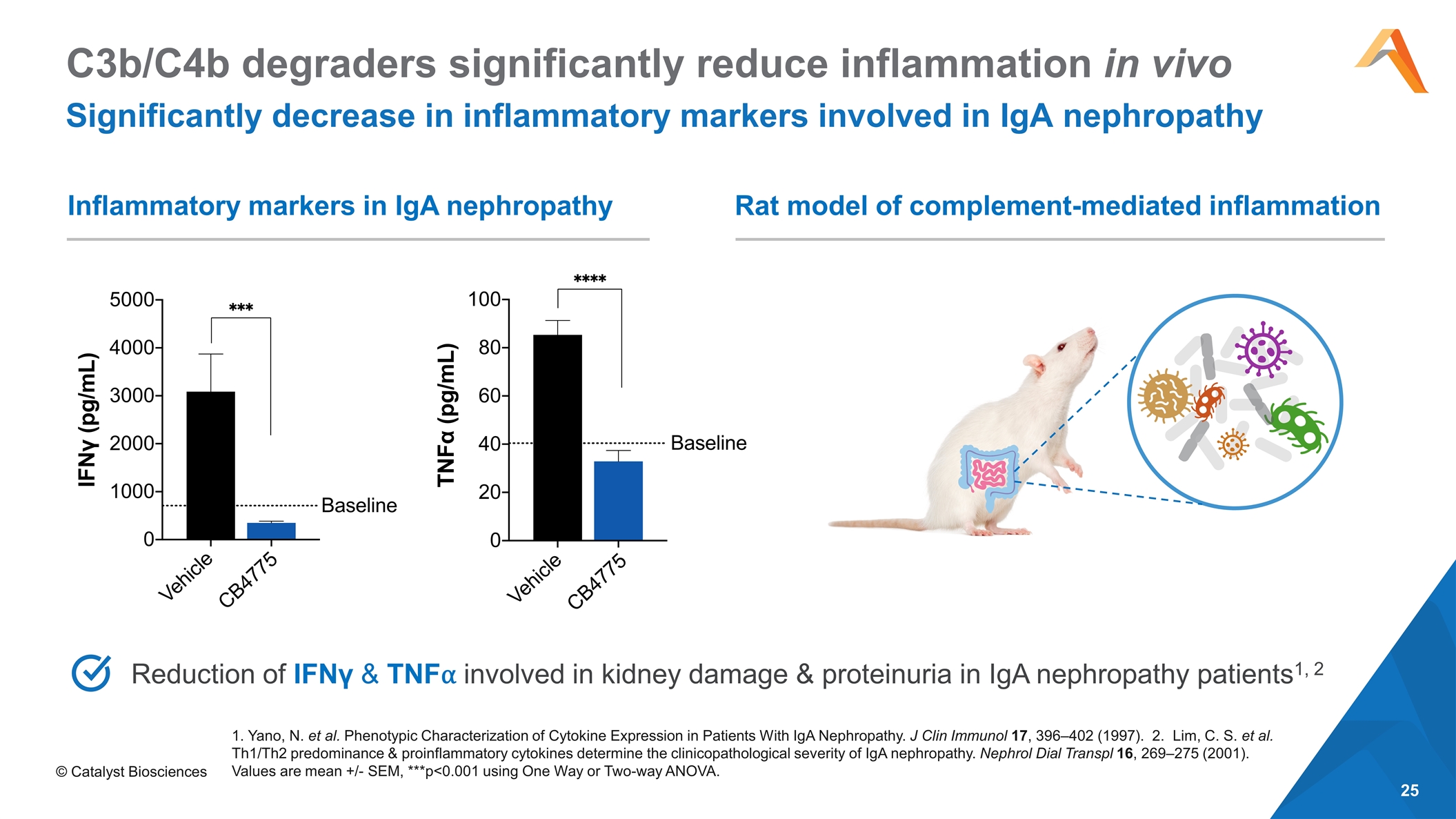
C3b/C4b degraders significantly reduce inflammation in vivo Significantly decrease in inflammatory markers involved in IgA nephropathy Inflammatory markers in IgA nephropathy Reduction of IFNγ & TNF⍺ involved in kidney damage & proteinuria in IgA nephropathy patients1, 2 1. Yano, N. et al. Phenotypic Characterization of Cytokine Expression in Patients With IgA Nephropathy. J Clin Immunol 17, 396–402 (1997). 2. Lim, C. S. et al. Th1/Th2 predominance & proinflammatory cytokines determine the clinicopathological severity of IgA nephropathy. Nephrol Dial Transpl 16, 269–275 (2001). Values are mean +/- SEM, ***p<0.001 using One Way or Two-way ANOVA. Rat model of complement-mediated inflammation © Catalyst Biosciences
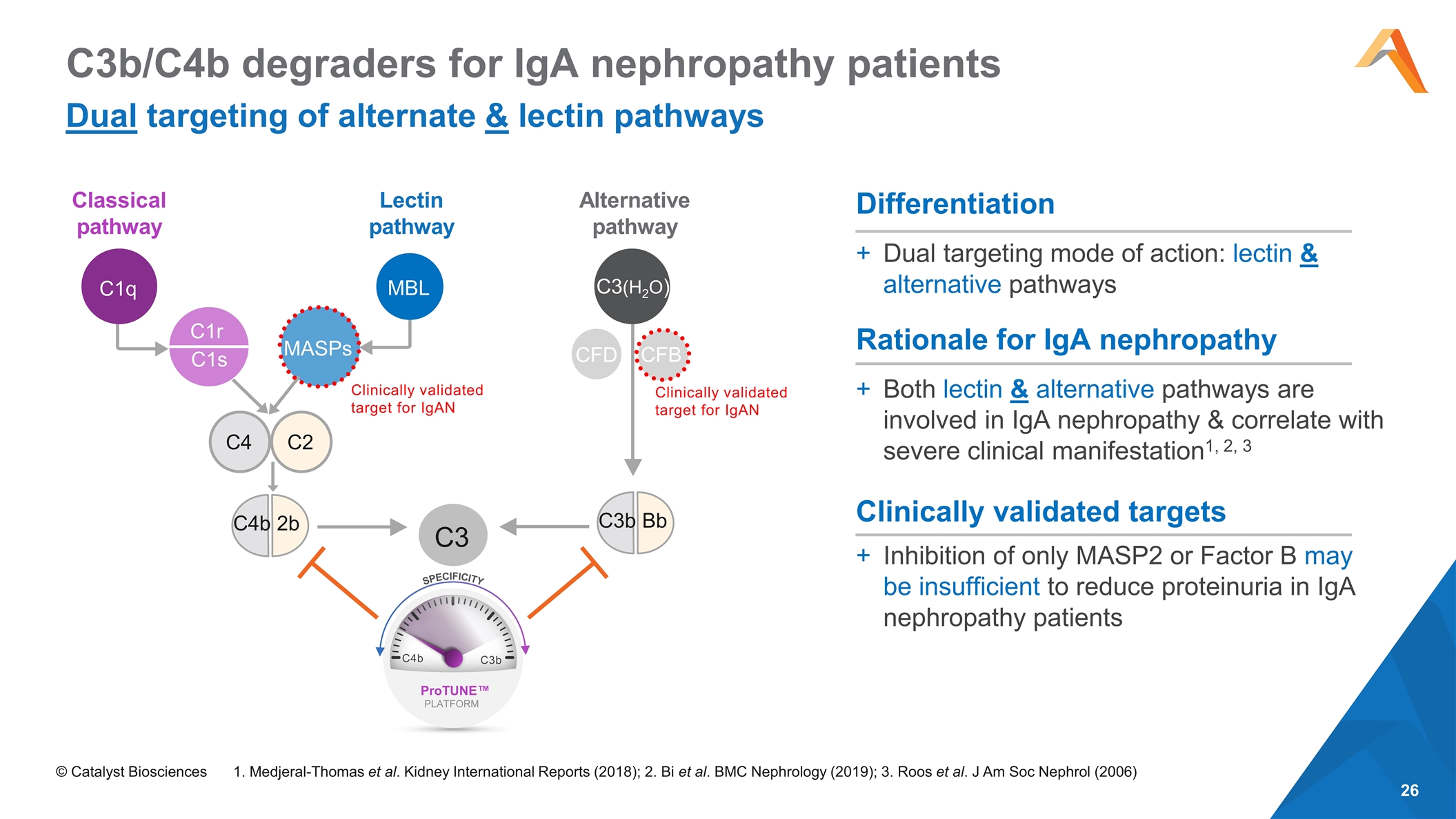
C3b/C4b degraders for IgA nephropathy patients Dual targeting of alternate & lectin pathways Classical pathway Lectin pathway C4 C2 C1r C1s MASPs C1q MBL C4b 2b C3 Alternative pathway CFB C3(H2O) CFD C3b Bb Differentiation Dual targeting mode of action: lectin & alternative pathways Rationale for IgA nephropathy Both lectin & alternative pathways are involved in IgA nephropathy & correlate with severe clinical manifestation1, 2, 3 Clinically validated targets Inhibition of only MASP2 or Factor B may be insufficient to reduce proteinuria in IgA nephropathy patients Clinically validated target for IgAN 1. Medjeral-Thomas et al. Kidney International Reports (2018); 2. Bi et al. BMC Nephrology (2019); 3. Roos et al. J Am Soc Nephrol (2006) Clinically validated target for IgAN SPECIFICITY ProTUNE™ PLATFORM C4b C3b © Catalyst Biosciences
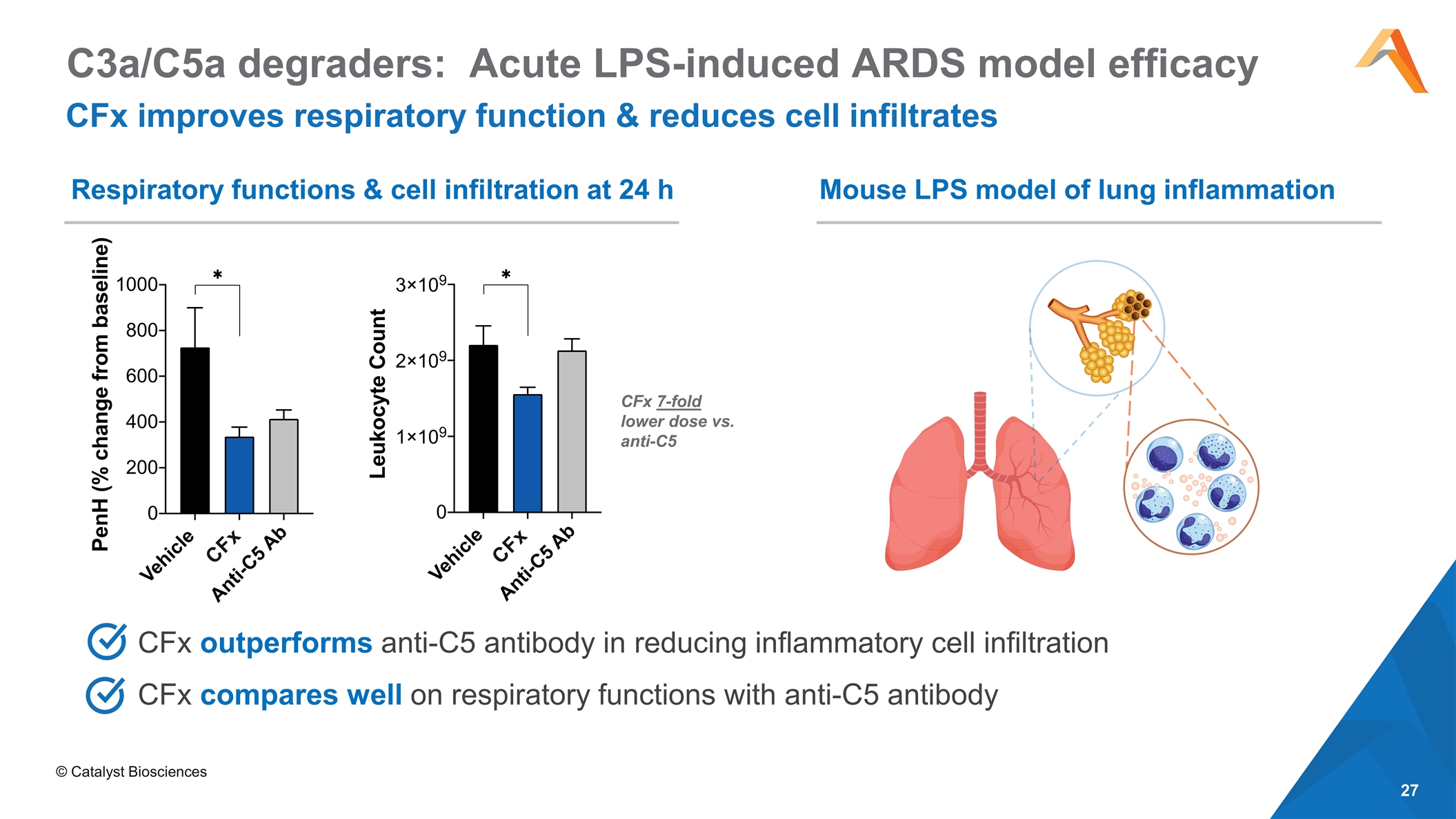
C3a/C5a degraders: Acute LPS-induced ARDS model efficacy CFx improves respiratory function & reduces cell infiltrates CFx 7-fold lower dose vs. anti-C5 Respiratory functions & cell infiltration at 24 h CFx outperforms anti-C5 antibody in reducing inflammatory cell infiltration CFx compares well on respiratory functions with anti-C5 antibody Mouse LPS model of lung inflammation CFx CFx © Catalyst Biosciences
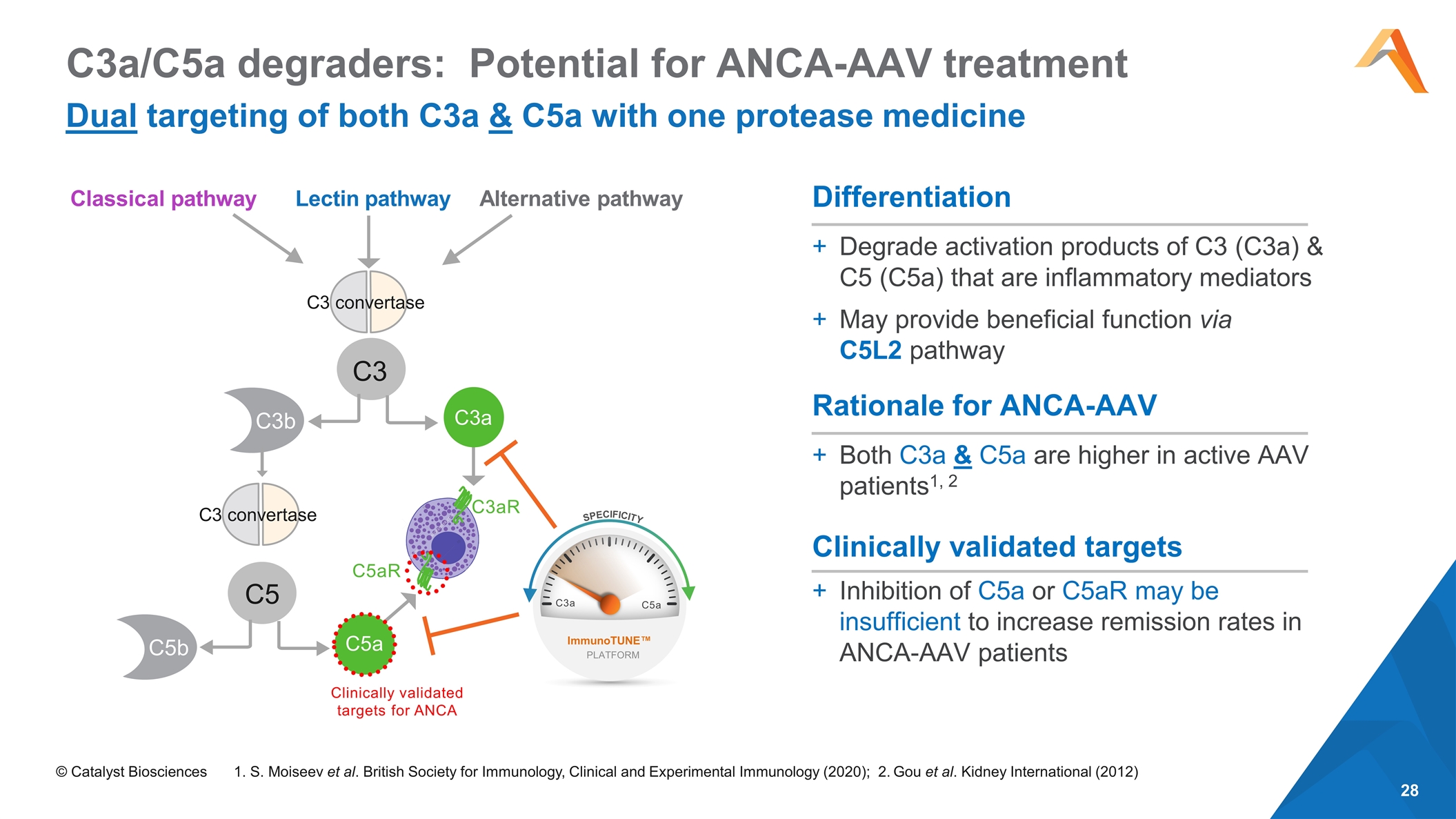
C3a/C5a degraders: Potential for ANCA-AAV treatment Dual targeting of both C3a & C5a with one protease medicine C3b C3 C5 C3a C5a C5b C3 convertase C3 convertase C3aR C5aR Clinically validated targets for ANCA Differentiation Degrade activation products of C3 (C3a) & C5 (C5a) that are inflammatory mediators May provide beneficial function via C5L2 pathway Rationale for ANCA-AAV Both C3a & C5a are higher in active AAV patients1, 2 Clinically validated targets Inhibition of C5a or C5aR may be insufficient to increase remission rates in ANCA-AAV patients Classical pathway Lectin pathway Alternative pathway ImmunoTUNE™ PLATFORM C3a C5a SPECIFICITY 1. S. Moiseev et al. British Society for Immunology, Clinical and Experimental Immunology (2020); 2. Gou et al. Kidney International (2012) © Catalyst Biosciences
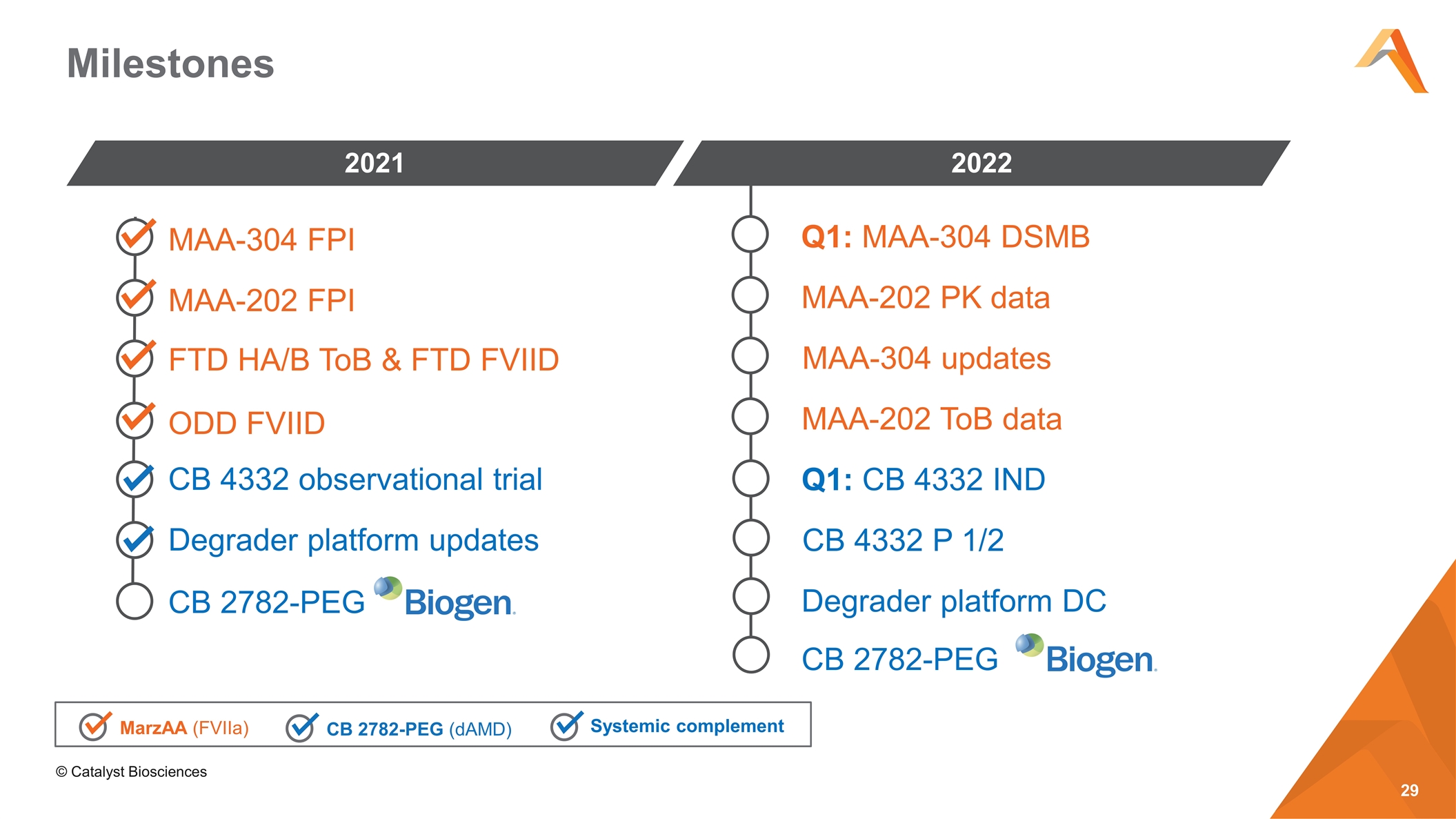
Degrader platform updates 2022 MarzAA (FVIIa) CB 2782-PEG (dAMD) Systemic complement MAA-202 ToB data Degrader platform DC Q1: CB 4332 IND MAA-304 updates CB 4332 P 1/2 Milestones 2021 © Catalyst Biosciences MAA-202 PK data Q1: MAA-304 DSMB CB 2782-PEG MAA-202 FPI MAA-304 FPI ODD FVIID FTD HA/B ToB & FTD FVIID CB 4332 observational trial CB 2782-PEG
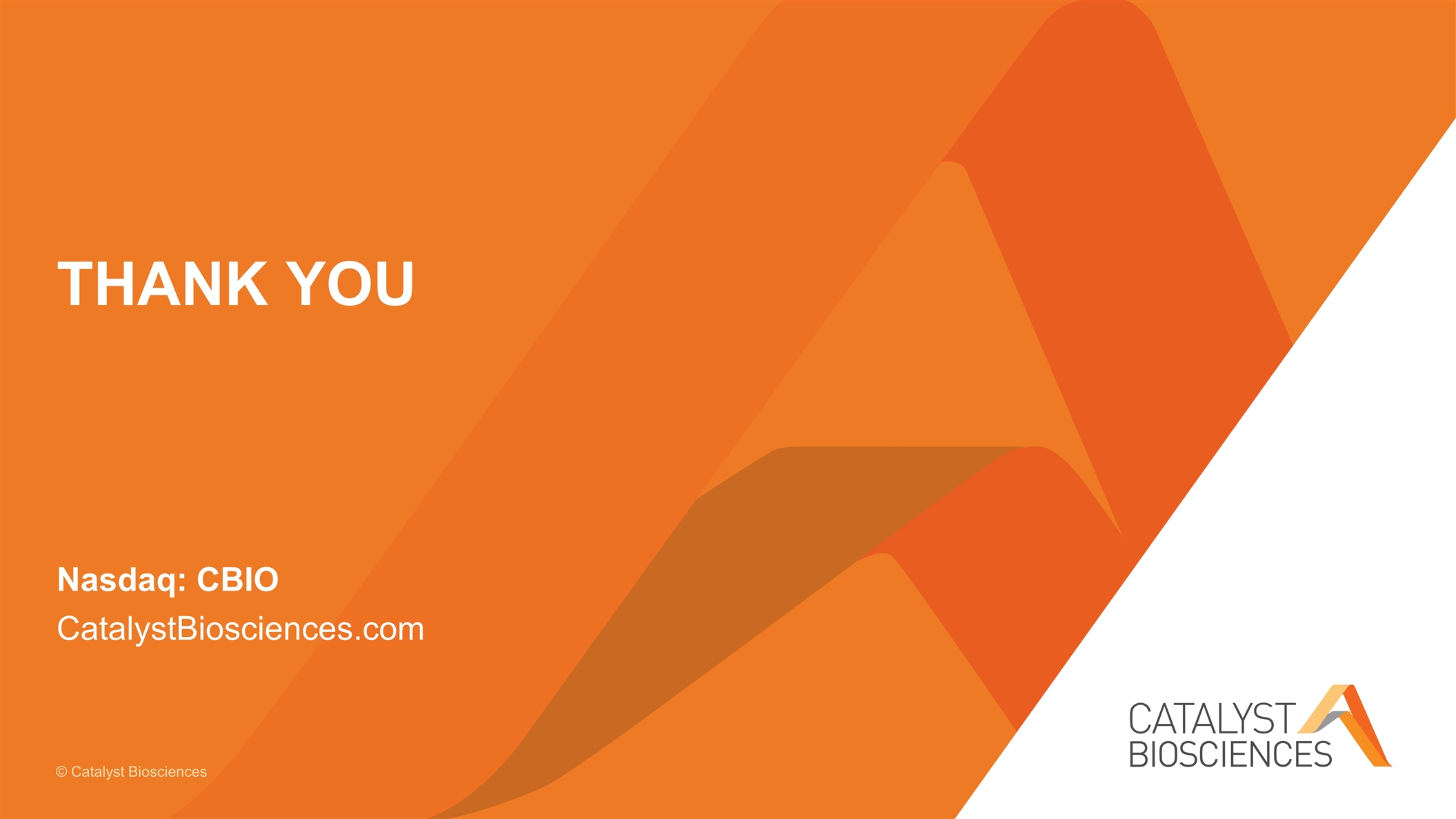
Thank You © Catalyst Biosciences Nasdaq: CBIO CatalystBiosciences.com
Serious News for Serious Traders! Try StreetInsider.com Premium Free!
You May Also Be Interested In
- Mowi ASA (OSE:MOWI): Q1 2024 Trading update
- BioSenic S.A. : Transparency notifications received from François Rieger
- Nokia Corporation Interim Report for Q1 2024
Create E-mail Alert Related Categories
SEC FilingsSign up for StreetInsider Free!
Receive full access to all new and archived articles, unlimited portfolio tracking, e-mail alerts, custom newswires and RSS feeds - and more!



 Tweet
Tweet Share
Share